Article and photos by Joe Sapia

Gulls flying above a dune along the Atlantic Ocean at Spring Lake, Monmouth County.
DRIVE-BY NATURALIST: As I was driving along a road in Monroe, Middlesex County, I looked at farmland and saw two birds — a red-tailed hawk, “Buteo jamaicensis,”on a dead animal, the other, a turkey vulture, “Cathartes aura,” standing aside. When the red-tail left, the turkey vulture began feasting on the dead animal, while another turkey vulture flew in. It appears the turkey vultures were not messing with a red-tail.
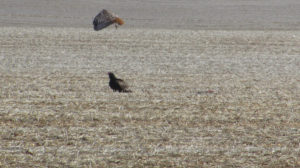
Photo 1: A turkey vulture, bottom, awaits its turn on a dead animal, to the right of the vulture, as a red-tail hawk got done eating and flies away. Moral of this story: Do not mess with a red-tail.

Photo 2: The red-tail flies off.
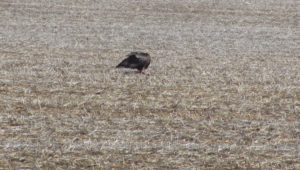
Photo 3: The turkey vulture gets its turn on the dead animal.

Photo 4: Another turkey vulture flies in.
HOLLYWOOD AND THE RED-TAILED HAWK: “The Red-tailed Hawk has a thrilling, raspy scream that sounds exactly like a raptor should sound,” according to Cornell University’s All About Birds website. “At least, that’s what Hollywood directors seem to think. Whenever a hawk or eagle appears onscreen, no matter what species, the shrill cry on the soundtrack is almost always a Red-tailed Hawk.” The site adds, “This is probably the most common hawk in North America. If you’ve got sharp eyes, you’ll see several individuals on almost any long car ride, anywhere.”

A red-tailed hawk flies over field and farmland on the boundary of Monroe and Cranbury in Middlesex County.
SNOW: From the snowfall of Tuesday to Thursday, March 20 to 22, the National Weather Service is reporting the following totals by county. They are broken down, here, by the low number of inches to the high number, but they may not reflect complete totals from around each county:
Burlington County: 7.3 inches in Cinnaminson to 11.9 inches in Mount Holly.
Hunterdon County: 6.7 in Wertsville to 14 in the Byram area.
Mercer County: 6 in the Princeton area to 9.1 in the Hightstown area.
Middlesex County: 5 in south Old Bridge to 12.5 at Cheesequake. (I recorded about 11 inches in the part of Monroe between Helmetta and Jamesburg.)
Monmouth County: 8.5 in Keyport to 13 in Lincroft.
Ocean County: 5.8 in the Lakehurst area to 15 in Lacey.
Somerset County: 5.6 in Watchung to 8.5 in the Bedminster area.
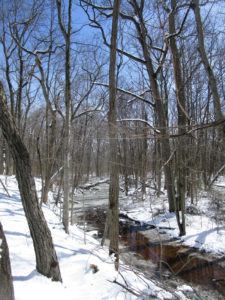
Turtle Creek on the Helmetta-Monroe boundary in Middlesex County after the Tuesday to Thursday, March 20 to 22, snowfall.
SNOWFALL TO DATE: At my house in Monroe, Middlesex County, the season’s snowfall to date has been 40.5 inches. Normal at New Brunswick, Middlesex County, or about 7.5 miles away, is about 26 inches. We are well past normal, with about three weeks of snow season to go. Interestingly, nearly half the snowfall, or 19 inches, has been in the last three weeks — of March!
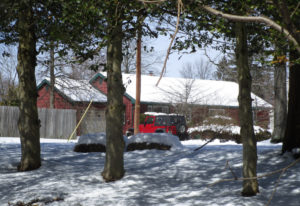
Joey’s house in Monroe, Middlesex County, in the snow.
CLIMATE CHANGE AND THE WEATHER: Jennifer Francis, a research professor at Rutgers Univeristy, talks about climate change’s impact on weather, http://www.philly.com/philly/opinion/commentary/climate-change-noreaster-spring-snow-opinion-20180322.html.

The Wednesday, March 21, nor’easter party at the Hightstown Diner, Mercer County.
GARDEN WRITING: The “Garden Writing” course I am teaching in the Princeton Adult School began this week. So, I have spent some time reading student papers, covering such topics as farm life in Delaware, Hunterdon County; orchids; Grandma’s pansies; and a lemon tree. All the papers have been enjoyable reads by area writers.
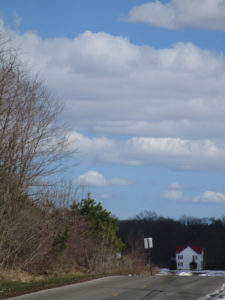
A farm scene in the Applegarth section of Monroe, Middlesex County.
MY GARDEN, NO. 1, PLANTING: The back portion of my backyard has as far back as I can remember in my 61 years been called “The Garden,” where my father, Joe Sr., and Grandma Annie Poznanski Onda grew vegetables and fruit. I still garden it, that patch being about 15 feet in depth and 75 feet in width, or a little more than 1,100 square feet. Before this week’s snow, I plowed up The Garden. Some look to St. Patrick’s Day, March 17, to plant peas and I had my Burpee Sugar Snap Peas in hand, but I viewed St. Paddy’s Day as too early. Instead, I was looking to plant the peas in early April. Finally, on Saturday, March 24, I broke down and planted two rows, or about 30 feet, of the Burpee Sugar Snap Peas. I also planted a row, or about 15 feet, of Burpee heirloom Touchon Carrot, because I had some old seeds around.

“The Garden” plowed up in my backyard in Monroe, Middlesex County.
MY GARDEN, NO. 2, ORDERING SEEDS: I ordered the rest of my early garden seeds, along with the summer garden stuff, all from Burpee. The early stuff: heirloom Touchon Carrot, Kaleidoscope Blend Carrot, Salad Bowl Lettuce, Early Wonder Beet, and heirloom Bloomsdale Long Standing Spinach. The summer seeds: Red Currant cherry tomatoes, heirloom Rutgers Tomato, Silver Queen Hybrid Corn, Straight Eight Organic Cucumber, heirloom Big Mama Lima Bean, and heirloom Hales Best Jumbo Cantaloupe. Also for the summer season, I bought various varieties of Burpee zinnia for fresh cuts and to attract pollinators — Envy, Candy Cane Mix, Old Mexico, Forecast, and Raspberry Lemonade Mix.
MY GARDEN, NO. 3, ZINNIA: Last year was the first year I grew zinnia. I bought them to attract pollinators, which they did — especially various species of butterfly. And I always had fresh cuts. Zinnia, too, are easy to grow. Also nice about zinnia is it being an annual, so I am not introducing an invasive non-native plant. I fell in love with zinnia. This year, I plan on putting the seeds of various varieties in a jar, shaking the jar, and planting the seeds in a big mix. So far, I plan these Burpee varieties — Envy, Candy Cane Mix, Old Mexico, Forecast, Raspberry Lemonade Mix, Cut and Come Again, Giant Flowered, and Big Tetra. If I need more, I will buy more. If I have too much seed, I will save the extra or take the view, “You cannot have too much zinnia seed.”
ELSEWHERE IN THE YARD: Ma (Sophie Onda Sapia) died at 81-years-old in 1995. But her flowers still grow in the front yard.

Ma’s flowers in the front yard of my home in Monroe, Middlesex County.
FULL MOON: The next full moon is Saturday, March 31, the second full moon of March. The first one was March 1.

A half-moon with clouds passing in front of it, as viewed from my backyard in Monroe, Middlesex County.
SUNRISE AND SUNSET: For the week of Sunday, March 25, to Saturday, March 31, the sun will rise from about 6:55 to 6:45 a.m. and set about 7:15 to 7:20 p.m. For the week of Sunday, April 1, to Saturday, April 7, the sun will rise about 6:40 to 6:30 a.m. and set 7:20 to 7:30 p.m.
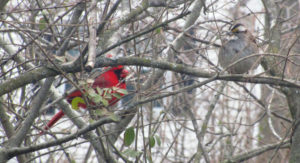
A cardinal, “Cardinalis cardinalis,” and a white-throated sparrow, “Zonotrichia albicollis,” in my sideyard in Monroe, Middlesex County.
ATLANTIC OCEAN TEMPERATURE: The Atlantic Ocean temperature off New Jersey is about 40 degrees.

A calm, flat Atlantic Ocean at Sea Girt, Monmouth County.
WEATHER: The National Weather Service office serving the Jersey Midlands is at https://www.weather.gov/phi/.
A HAWK?: Have you ever heard a blue jay cry like a hawk? “The blue jay frequently mimics the calls of hawks, especially the red-shouldered hawk” according to Cornell University’s All About Birds website. “These calls may provide information to other jays that a hawk is around, or may be used to deceive other species into believing a hawk is present.”
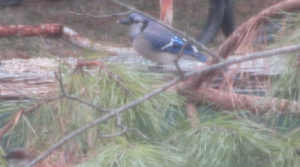
A blue jay, “Cyanocitta cristata,” helping itself to sunflower seeds in the backyard of my Monroe, Middlesex County, home.
SKY PHOTOS: This week’s sky photographs are from Monroe and Cranbury in Middlesex County.
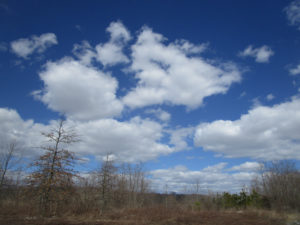
The Wyckoff’s Mills section of Monroe, Middlesex County.
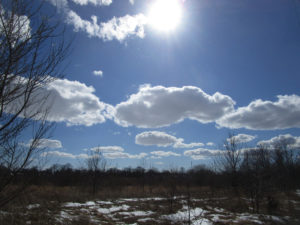
The Wyckoff’s Mills section of Monroe, Middlesex County.
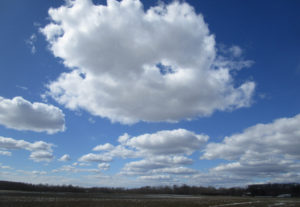
The sky over farmland in Cranbury, Middlesex County.

A dusk view from my backyard in Monroe, Middlesex County.
HEARINGS ON GAS PIPELINE EXPANSION: The Federal Energy Regulatory Commission (FERC) has schedule hearings on the “draft environmental impact statement” for the Northeast Supply Enhancement project’s natural gas pipeline expansion through the Jersey Midlands. Hearings are scheduled for:
April 25, Wednesday, 5 to 9 p.m., in Middlesex County, Old Bridge, at the George Bush Senior Center.
April 26, Thursday, 5 to 9 p.m., in Brooklyn, New York, at the Best Western Gregory Hotel.
May 2, Wednesday, 5 to 9 p.m., in Somerset County, Franklin, at the Franklin Township Community Center.
May 3, Thursday, 5 to 9 p.m., in Quarryville, Pennsylvania, at Solanco High School.
April 7, Saturday, 8 a.m.: New Jersey’s trout fishing season formally opens.
April 9 to 15, Monday to Sunday, Mercer County: The annual Princeton Environmental Film Festival, https://www.princetonlibrary.org/peff/.
In my front yard in Monroe, Middlesex County, the Wednesday-Thursday, March 21-22, nor’easter ends. This photograph reminds me of “Scout Vespers,” a song we sang at Boy Scout Troop 81 meetings, “Softly falls the light of day as our campfire fades away….”
Joe Sapia, 61, is a lifelong resident of Monroe — in South Middlesex County, where his maternal family settled more than 100 years ago. He is a Pine Barrens naturalist and an organic gardener of vegetables and fruit, along with zinnias and roses. He loves the Delaware River north of Trenton and Piedmont, too.
He draws inspiration on the Pine Barrens around Helmetta from his mother, Sophie Onda Sapia, who lived her whole life in these Pines, and his Polish-immigrant grandmother, Annie Poznanski Onda.
He gardens the same backyard plot as did his Grandma Annie and Italian-American father, Joe Sr. Both are inspirations for his food gardening. Ma inspires his rose gardening.
Joe is a semi-retired print journalist of almost 40 years. His work also is at @JosephSapia on Twitter.com, along with Facebook.com on the Jersey Midlands page.
Copyright 2018 by Joseph Sapia
Article and photos by Joe Sapia
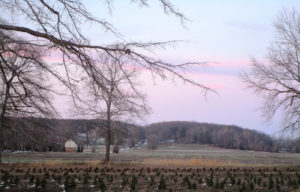
Arneys Mount in Springfield, Burlington County.
ARNEYS MOUNT: Arneys Mount stands roughly 245 feet above sea level, or about 175 feet above the surrounding lowland, in Springfield, Burlington County. It is part of the cuesta geologic formation — hills that have survived erosion and now separate New Jersey’s Outer Coastal Plain and Inner Coastal Plain. Take a map a draw a line from Sandy Hook at the Atlantic Ocean in Monmouth County to the Burlington County area of Mount Holly-Mount Laurel. That line is essentially the line of the cuesta. On a detailed map of that line, you will see names representing the hill system — Highlands, Mount Mitchell, Crawford Hill, Telegraph Hill, Beacon Hill, Knob Hill, Locust Hill, Quail Hill, Pine Hill, Backbone Hill, Disbrow Hill, Crematory Hill, Stone Hill, Arneys Mount, Mount Holly, and Mount Laurel.
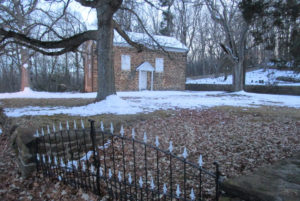
The circa 1775 Arneys Mount Friends Meeting House.
VOICES FROM AFIELD NO. 1, THE CUESTA: Cousin Jerry Edvy lives on high ground just outside of Perrineville in Millstone, Monmouth County. When it snowed during the Tuesday, March 13, nor’easter, he reported “at least 5 inches.” His house is on the cuesta, or about 280 feet above sea level. When Jerry drove off the cuesta, he saw hardly any snow. “(Route) 33 was clear,” said Jerry, speaking of the road about 3 miles north of his house. “We must have got hit with a band,” he said. Or maybe it was just the height of his area. My house, about 50 feet above sea level about 10 miles to the north, got only about 1 inch of snow. I recall this cuesta-lowland dichotomy several years ago during my newspaper reporting days for the Asbury Park Press as I drove in Monmouth County from the Millstone area to the Sandy Hook area — when I was on high points of the cuesta, there was a covering of snow, maybe a few inches; when I was at lower elevations, maybe just a coating. An interesting phenomena happening in only a matter of dozens of feet.
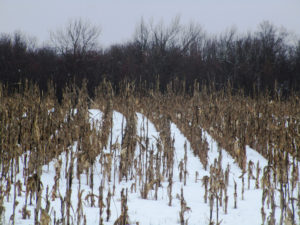
The Tuesday, March 13, nor’easter snowfall in a Monroe Township, Middlesex County, cornfield.
SNOWFALL: The seasonal snowfall tally at my house in the part of Monroe between Jamesburg and Helmetta is 29.0 inches. The average seasonal snowfall in New Brunswick, about 7.5 miles away, is about 26 inches. So, based on that, we are about 3 inches more than normal at my house, with about a month’s worth of snowfall season left.
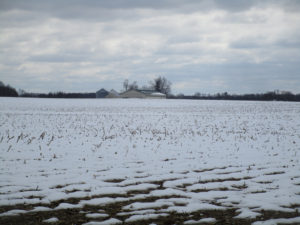
The Tuesday, March 13, nor’easter snowfall at a farm in Plainsboro, Middlesex County.
FOREST FIRE SEASON: Because of the wet weather, the Pine Barrens spring wildfire season in the Jersey Midlands is running behind this year. Normally, it runs March 15 to May 15, when winds blow, humidity decreases, temperatures rise, and sun penetrates the essentially leafless forest, warming and drying the duff. But with the wetness out there, for example, the state Forest Fire Service canceled a control-burn for the upcoming week in the Jamesburg Park Conservation Area in Middlesex County.
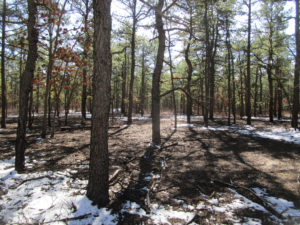
Snow on the ground in the Pine Barrens of Barnegat, Ocean County.
FIRE TOWERS: The idea of a fire tower is to see smoke during daylight hours, basically to dispatch firefighters before a fire really gets going. Because once flames are seen, the fire is well underway. The state Forest Fire Service has eight wildfire lookout towers in the Jersey Midlands — Apple Pie Hill, Bass River, Batsto, Lebanon, and Medford, all in Burlington County; Cedar Bridge and Lakewood, both in Ocean County; and Jamesburg, Middlesex County. When the fire towers are staffed, the public is welcome to visit. Beware, though, it can be a climb of about 60 to 100 feet, depending on the tower.
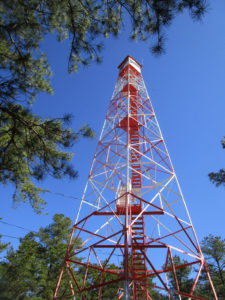
BASS RIVER STATE FOREST: Trees are to be cut around the Bass River fire-lookout tower in Bass River State Forest to improve the view for the tower observer. See https://thesandpaper.villagesoup.com/p/clear-cutting-proposed-for-bass-river-state-forest-fire-protection/1729679.
PYGMY PINES: Generally in the area of the intersection of Routes 72 and 539 in Ocean County stand hundreds of acres of Pine Barrens forest with trees perhaps only 8-feet-tall at most. This is the “Pygmy Pines” or “The Plains.” The theory is the stunted growth in this area is caused by repeated fires.
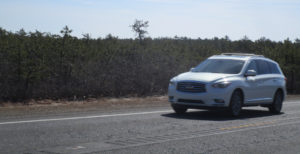
A sport utility vehicle drives on Route 539 through the Pygmy Pines, or Plains, in the Pine Barrens outside of Warren Grove, Ocean County.
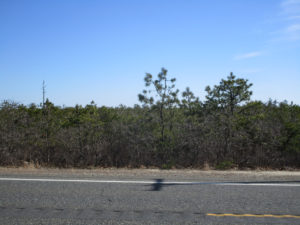
The Pygmy Pines, or Plains, on Route 539 in the Pine Barrens near Warren Grove, Ocean County.
WITCH’S BROOM: If you regularly walk the Pine Barrens, you are likely to have seen a “witch’s broom,” a thick growth of needles on a pitch pine, “Pinus rigida.” While it may look haunting, it is simply caused by disease, defect, infestation, or environmental stress.
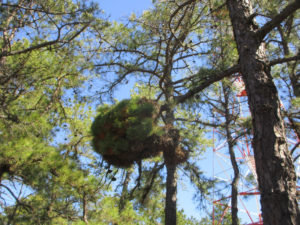
A “witch’s broom” growth on a pitch pine, “Pinus rigida,” at the Cedar Bridge fire-lookout tower in Barnegat, Ocean County.
PAINTED ROCK IN THE PINE BARRENS: Going back years, a rock along Route 539, on the section between Routes 70 and 72 in Lacey, Ocean County, had been painted in different ways according to the calendar — a Halloween jack-o-lantern, a turkey for Thanksgiving, and so on. But the rock, apparently on its way by truck to the Jersey Shore for erosion control when it somehow wound up along the road, took on an American flag, patriotic theme after 9-11 — the 2001, September 11, Tuesday, terrorist attack on American soil. No matter the artwork, the rock remains a landmark in the Pine Barrens. For more information on the rock, see http://www.jamesrahn.com/pages/other/personal/rock.htm.
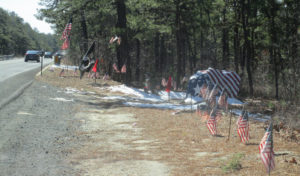
Since around 9-11 — the terrorist attack on American soil on 2001, September 11, Tuesday — the rock on Route 539 in the Pine Barrens of Lacey, Ocean, has taken on a patriotic theme.
PROTECTED ‘PINELANDS’: While much of the Pine Barrens is protected by state “Pinelands” regulations, it is not true the Pine Barrens are fully preserved. One, not all the Pine Barrens is regulated for environmental protection. Two, building is allowed even in the regulated area.

The (un)American way, development in the Pine Barrens, here in Whiting, Ocean County.
CROSSWICKS CREEK: Crosswicks Creek’s headwaters are in the area of New Egypt, Ocean County. It, then, flows into the Delaware River at Bordentown. The federal Geological Survey has a gauge along Crosswicks Creek at Extonville on the boundary of Burlington and Mercer counties, https://waterdata.usgs.gov/nwis/uv/?site_no=01464500. Along the waterway is Crosswicks Creek Park, part of the Monmouth County Park System, https://www.monmouthcountyparks.com/page.aspx?Id=2568.
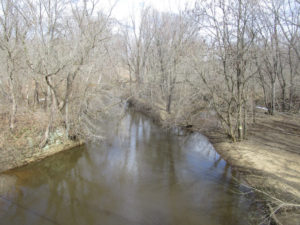
Looking upstream on Crosswicks Creek, here on the boundary of Mercer County to the left and Burlington County to the right. Here, Crosswicks Creek separates the villages of North Crosswicks in Hamilton, Mercer County, and Crosswicks in Chesterfield, Burlington County.
READING THE ENVIRONMENT: When walking afield, let the land talk to you. It has a historical record. For example, the other day I was telling Eric Gehring, a naturalist for the Middlesex County Office of Parks and Recreation, about the dikes in the woods across Manalapan Brook from my house. Those dikes are a record of the area’s cranberry farming that ended around World War II. Then, during the week, on a portion of Manalapan Brook about 4 miles south of my house, I noticed wood planks sticking out of the ground. Remnants of a bridge? A dam? This remains a mystery.
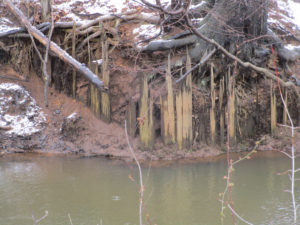
Remnants of a wooden structure on Manalapan Brook in southern Monroe, Middlesex County.
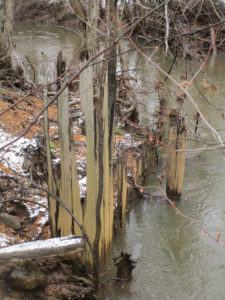
The wooden remnants on Manalapan Brook in southern Monroe, Middlesex County.
VOICES FROM AFIELD NO. 2, A MINK: Frank Ulatowski, an Englishtown-Manalapan outdoorsman, reported seeing a roadkilll of mink, “Mustela vison,” on Route 33 in Monroe, Middlesex County. So, mink are around.
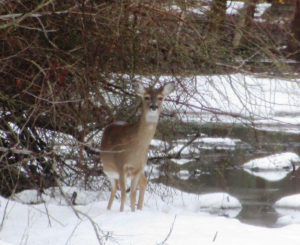
I came across this deer, “Odocoileus virginianus,” on a utility line on the boundary of Hightstown and East Windsor in Mercer County. Deer live on the edge — the edge of the woods, where they seek refuge, and fields, where they browse.
CHANJ: The state Division of Fish and Wildlife is promoting its initiative of CHANJ — Connecting Habitat Across New Jersey. CHANJ is looking to protect habitat and connect habitat through such things as land purchase, management of land, and safe wildlife passage at roadways. Roadway mitigation could include using culverts and bridges to have a safe pathway for wildlife to cross roads. The idea is have connectivity using core areas, which could be as little as 200 acres to as big as state regions such as the Highlands of North Jersey and, locally, the Pine Barrens.
UPPER MILLSTONE RIVER EAGLES: It appears the pair of bald eagles, “Haliaeetus leucocephalus,” are feeding chicks in the Upper Millstone River nest on the boundary of Mercer and Middlesex counties, based on one adult on the nest while another flies to it. See the series of photographs:
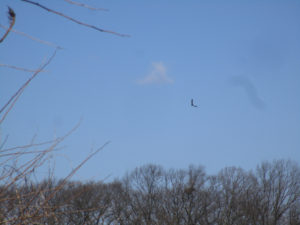
Photo 1: An adult bald eagle circles the Upper Millstone River nest, which is below the eagle.
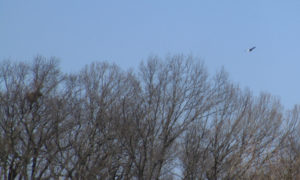 Photo 2: The eagle continues to circle, its white tail easily seen in this photograph. The nest is to the left.
Photo 2: The eagle continues to circle, its white tail easily seen in this photograph. The nest is to the left.
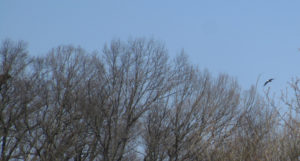
Photo 3: The eagle circles back toward the nest, which is to the left, its white head clearly seen.
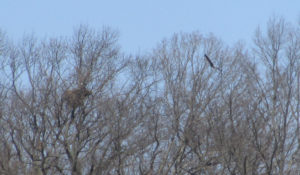
Photo 4: The eagle flies toward the nest, which is to the left, where its mate awaits. The mate’s head is the speck of white above the nest.
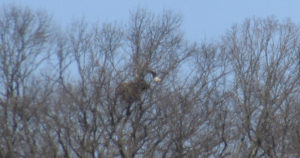
Photo 5: The eagle is landing on the nest, its mate awaiting.
VOICES FROM AFIELD NO. 3, UPPER MILLSTONE RIVER EAGLES: Frank Ulatowski, an outdoorsman from Englishtown-Manalapan, and his wife, Charlene, were visiting a business in the area of the Upper Millstone River nest of bald eagles, “Haliaeetus leucocephalus,” on the boundary of Mercer and Middlesex counties when a bald eagle flew by near the top of one of the single-story buildings. Frank wondered with all people around, how many noticed the eagle — as breeders in New Jersey, bald eagles are “endangered,” or under immediate peril, and, in general, “threatened,” or a species that can become “endangered” if conditions continue.
DUKE FARMS EAGLE CAMERA: At Duke Farms in Hillsborough, Somerset County, bald eagles, “Haliaeetus leucocephalus,” are sitting on two eggs, the first of which is scheduled to hatch about Wednesday, March 21. There is a live-stream camera on the nest that can be seen at http://dukefarms.org/making-an-impact/eagle-cam/. In New Jersey, bald eagles are “endangered,” or under immediate peril, as breeders and, in general, “threatened,” or a species that can become “endangered” if conditions continue.
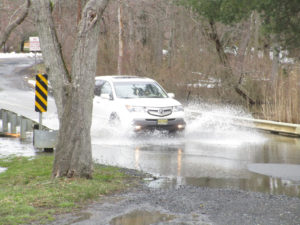
The March 13, Tuesday, nor’easter flooding on the boundary of Plainsboro and South Brunswick, Middlesex County.
BATSTO LAKE: Batsto Lake in Wharton State Forest, Burlington County, is formed by the damming of the Batsto River. The lake is 40 acres, according to the New Jersey Fish Finder website. As for the river, it drains 67.8 square miles, according to the federal Geological Survey.
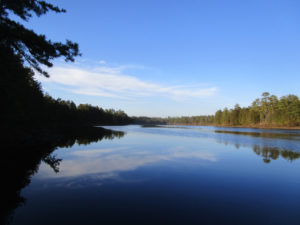
Batsto River in Wharton State Forest, Burlington County.
SIGNS OF THE PINES: While traveling through the main part of the Pine Barrens, I came across a few interesting signs, both in the Bass River State Forest area of Burlington County:

A folk art sign warning drivers of deer, “Odocoileus virginianus,” crossing a road near Bass River State Forest in Burlington County.
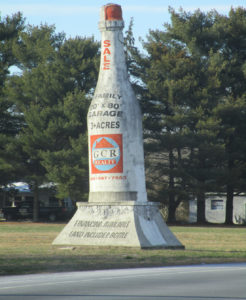
An old masonry advertising style — formerly announcing a winery, now advertising property for sale — on Route 9 near Bass River State Forest in Burlington County.
SKY VIEWS: This week’s sky views are from Hamilton, Mercer County, and Monroe, Middlesex County.

Farmland in Hamilton, Mercer County.
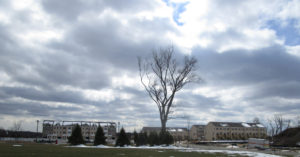
Mounts Mills Road in Monroe, Middlesex County.

Thompson Park, looking at Monroe High School, in Monroe, Middlesex County.
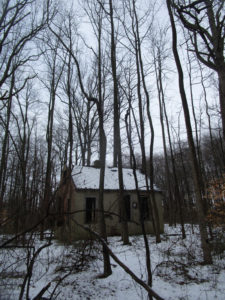
An abandoned cabin in the woods of Monroe, Middlesex County.
Joe Sapia, 61, is a lifelong resident of Monroe — in South Middlesex County, where his maternal family settled more than 100 years ago. He is a Pine Barrens naturalist and an organic gardener of vegetables and fruit, along with zinnias and roses. He loves the Delaware River north of Trenton and Piedmont, too.
He draws inspiration on the Pine Barrens around Helmetta from his mother, Sophie Onda Sapia, who lived her whole life in these Pines, and his Polish-immigrant grandmother, Annie Poznanski Onda.
He gardens the same backyard plot as did his Grandma Annie and Italian-American father, Joe Sr. Both are inspirations for his food gardening. Ma inspires his rose gardening.
Joe is a semi-retired print journalist of almost 40 years. His work also is at @JosephSapia on Twitter.com, along with Facebook.com on the Jersey Midlands page.
Copyright 2018 by Joseph Sapia
Article and photos by Joe Sapia

A nanny with two of her three new kids at Cranbury Brook Farm in Monroe, Middlesex County.
NEW KIDS IN TOWN: A few days ago, Laurie Ann Kozinsky Winter welcomed three “kids” to her Cranbury Brook Farm in Monroe — that is, three baby goats. On Sunday, March 4, Laurie Ann opened up her farm for a few hours so the community could visit the kids (all females) and their mom, the nanny.

The three young ladies at Cranbury Brook Farm.
As a lifelong Monroe resident of 61 years, I have watched the township of a little more than 43 square miles grow from an estimated 5,000 people to today’s estimated 50,000. So, today’s visit to the farm, which sits on Cranbury Brook, was a visit back in time — when the part of Monroe south of Jamesburg was simply “The Farms.”

A mother’s care at Cranbury Brook Farm.
My maternal Onda-Poznanski family and Laurie Ann’s maternal side have know each other for a hundred or so years. Laurie Ann’s maternal grandmother, Anna Kozinsky, and I lived in the same Helmetta Road area of Monroe. Laurie Ann and I are four days apart in age — Grrrrrr, I am the older one — and attended Holy Trinity Church in Helmetta and St. Mary School in South River — both Polish-Catholic institutions for us good Polski-Catholic children. At the farm, I got to talk to some of Laurie Ann’s children and caught up with her parents, Anna and Danny Kozinsky. So, it was a reunion of families, too.
What was supposed to be a short stay turned into about three hours — and about 120 photographs.

1967, January — Little Laurie Ann and little Joey, both 10-years-old, in the 5th grade at St. Mary School, South River, Middlesex County, where good Polish-Catholic kids went to school.
SHOUT OUT TO FARMER LAURIE ANN KOZINSKY WINTER: The GOAT (Greatest of All Time) — farm owner Laurie Ann Kozinsky Winter. Or as I call her, Princess Winter Spring Summer Fall. (Baby-boomers would understand the Princess moniker — and notice the mix-up of words.) A shout-out to Laurie Ann — A loving wife who lost her husband, Greg, over the summer after a long battle with cancer; she is very dedicated to her elderly parents; and she is a mother and grandmother. A Jersey Girl!
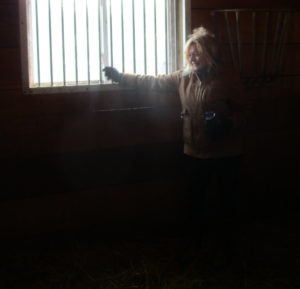
Laurie Ann Kozinsky Winter, owner of Cranbury Brook Farm in Monroe, Middlesex County.
MARCH 1 to 3 NOR’EASTER: We were still cleaning up from the March 1 to 3 nor’easter…
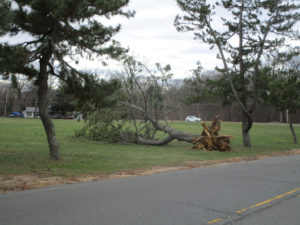
Here in Thompson Park in Monroe, Middlesex County, this fallen tree was a victim of the March 1 to 3 nor’easter. Then, on Wednesday, March 7, we got hit with another nor’easter…
MARCH 7 NOR’EASTER: Meteorologists were having trouble forecasting snow totals for the Wednesday, March 7, nor’easter. Where would the rain/snow line be? A difference of only a few miles could mean a drastic difference in snowfall — Look at the following figures from Somerset County, a 15-inch difference! The National Weather Service reported the following snowfall totals by county. I am listing the reported highs and lows. Keep in mind this may be an incomplete report:
Burlington County: 3.3 inches at Pemberton to 9.5 inches at Moorestown and Cinnaminson.
Hunterdon County: 6.0 in East Amwell to 15.5 in the Stockton area.
Mercer County: 6.1 in the Trenton-Ewing area to 11.5 at Hamilton.
Middlesex County: 2.0 in the Old Bridge area to 9.4 at Cranbury. (I recorded an estimated 6.0 at the part of Monroe between Helmetta and Jamesburg.)
Monmouth County: 1.3 at Keyport to 7.6 in the Upper Freehold area.
Ocean County: 0.4 at Lacey to 3.2 in the Jackson area.
Somerset County: 7.1 at Somerville to 22.0 at Green Brook.
Bucks County, Pennsylvania: 6.5 in the Oakford area to 11.1 in Langhorne.
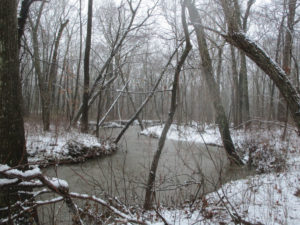
The S-curve of Manalapan Brook in Monroe, Middlesex County, known as the “Old Swimming Hole.”
SNOWFALL: With the Wednesday, March 7, nor’easter, where I live — in the Helmetta-Monroe-Jamesburg area of Middlesex county — has surpassed the seasonal snowfall average. The nor’reaster dropped 6 inches, bringing the seasonal total to 28 inches. Normal would be about 26 inches, based in New Brunswick about 7.5 miles away. And we still have about 4 weeks left in the snowfall season.
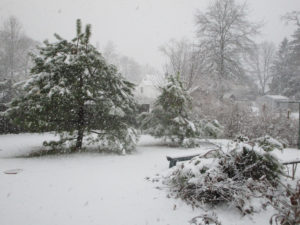
A March 7 nor’easter scene in my backyard in Monroe, Middlesex County.
OTHER SCENES FROM THE MARCH 7 NOR’EASTER:
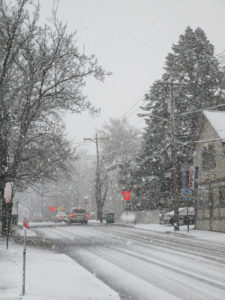
The snow begins in Hightstown, Mercer County.

A Monmouth County Department of Public Works And Engineering plow on Route 571 in the part of Millstone, Monmouth County, between Roosevelt and ETRA.
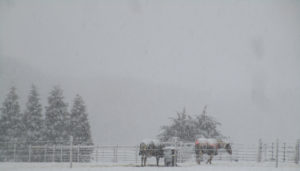
Horses in Roosevelt, Monmouth County.
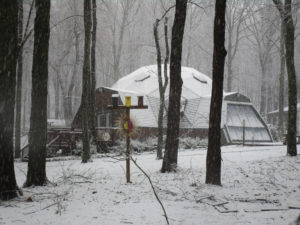
One of the famed geodisic dome houses in Roosevelt, Monmouth County.
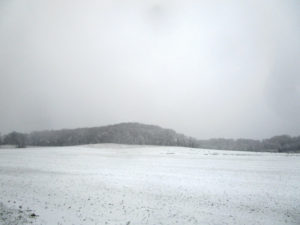
Disbrow Hill, or “Crematory Hill,” in Millstone, Monmouth County.
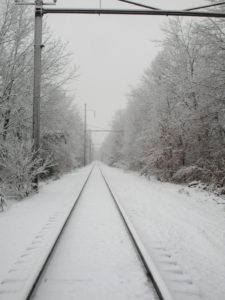
ConRail freight railroad tracks in the part of Monroe, Middlesex County, between Jamesburg and Helmetta.
HOW THESE NOR’EASTERS LIVE ON: We may not realize it, but we will see remnants of Wednesday’s nor’easter for years to come in fallen or bent trees, because of the high wind and the heavy, wet spring snow.
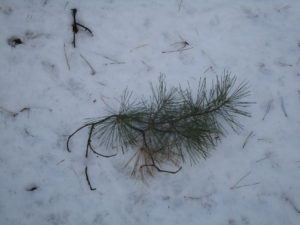
A branch of a pitch pine, “Pinus rigida,” that fell because of the March 7 nor’easter in an East Brunswick section of the Middlesex County Department of Parks and Recreation-operated Jamesburg Park Conservation Area. This is part of my beloved Pine Barrens around Helmetta.
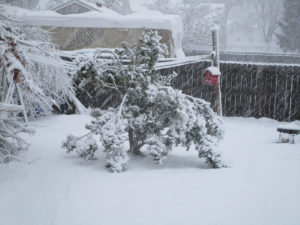
The heavy, wet spring snow bent this American holly, “Ilex opaca,” in my backyard in Monroe, Middlesex County. In heavy snows, I knock the snow off trees and shrubs in my yard.
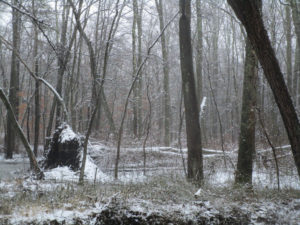
This swamp hardwood tree, about 60 feet in length, fell recently in the Manalapan Brook floodplan in Monroe, Middlesex County. The root pan is about 10-feet-tall. This is in woods I walk and I note trees that are lying to the west are probably remnants of 2012’s Superstorm Sandy, whose winds blew west, rather than the normal wind coming out of the west.
SIGNS OF SPRING: I have noticed male red-winged blackbirds, “Agelaius phoeniceus,” beginning to show their yellow and red epaulets, which they use to attract a female and likely signal territory. According to Cornell University’s All About Birds website, “The Red-winged Blackbird is a highly polygynous species, meaning males have many female mates – up to 15 in some cases. In some populations 90 percent of territorial males have more than one female nesting on their territories. But all is not as it seems: one-quarter to one-half of nestlings turn out to have been sired by someone other than the territorial male.”

A male red-winged blackbird is beginning to show his yellow and red epaulet, a sign of the mating season. This one was in a common position, feeding on the ground below a birdfeeder — in this case in my backyard in Monroe, Middlesex County.
WINTERING DUCKS: During the winter season, it is fun to see what is down here from the north. At Helmetta Pond in Middlesex County, I saw ducks of the genus “Aythya.”

Ducks of the genus “Aythya” on Helmetta Pond.
UPPER MILLSTONE RIVER EAGLES: Anne Price and I, the state Department of Environmental Protection volunteer monitors of this nest on the boundary of Middlesex and Mercer counties, believe the bald eagles, “Haliaeetus leucocephalus,” have a newly born chick or chicks in the nest. As breeders in New Jersey, bald eagles are “endangered,” or under immediate peril. For now, we just keep on watching the nest.
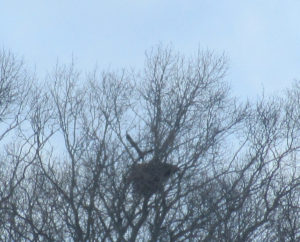
An adult bald eagle at the Upper Millstone River nest.
USGS GAUGES: My family through my maternal side has lived along Manalapan Brook in Helmetta or Monroe, Middlesex County, since 1900 or so. I was born, grew up, and am back living within 400 or so feet of the brook. So, I often use the brook’s United States Geological Survey stream flow gauge at Spotswood, Middlesex County, about 2 miles to the north as the crow flies, for research. For example, when the brook is running at about 50 cubic feet per second in Spotswood, I can no longer wade across the brook at my house — the velocity is too strong and maybe the brook is too high. And when the brook is running about 200 CFS in Spotswood, it is about to flow over its bank at my house. My added affinity to the Spotswood gauge is that it began operating in 1957, January, or two months after I was born — giving me almost a perfect record of brook flows of my lifetime. This week, I stumbled upon the USGS gauge on the Delaware and Raritan Canal at Kingston on the boundary of Middlesex, Mercer, and Somerset counties. See https://waterdata.usgs.gov/nj/nwis/uv/?site_no=01460500&PARAmeter_cd=00065,00060,62614 for the Kingston gauge. See https://waterdata.usgs.gov/nj/nwis/current/?type=flow for the stream flow gauges in New Jersey. There are more than 50 gauges in the Jersey Midlands.
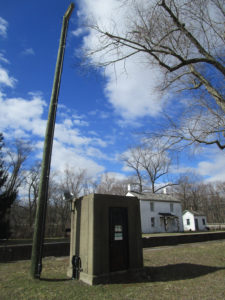
The United States Geological Survey stream flow gauge at Kingston on the boundary of Middlesex, Mercer, and Somerset counties.

Signs on the USGS stream flow gauge at Kingston.
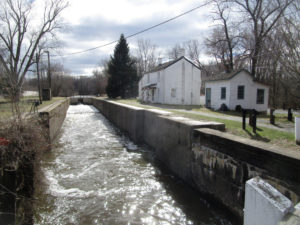
A lock of the Delaware and Raritan Canal at Kingston. The USGS gauge sits in the background, along the canal’s left bank.
CATCHING THE RIGHT LIGHT: On two days this week, I happened to catch views of soft sunlight on trees at dusk. And both times I captured it with my camera.
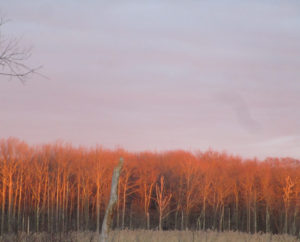
This shot is across the street from my house in Monroe, Middlesex County.
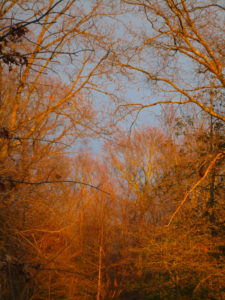
Another shot from across the street from my house.
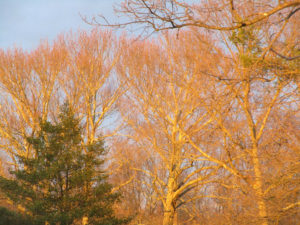
Another bit of golden sunlight at Monmouth Junction, Middlesex County.
SKY VIEWS: This week’s sky views were captured in East Brunswick, Helmetta, Monmouth Junction, and Monroe, Middlesex County, along with the Kingston area on the boundary of Middlesex, Mercer, and Somerset counties.

This photograph was taken at Thompson Park in Monroe, Middlesex County.

Helmetta Pond in the Pine Barrens around Helmetta, Middlesex County.

Carnegie Lake, formed by the damming of the Millstone River — this portion of the lake is on the boundary of Princeton, Mercer County; Plainsboro and South Brunswick, Middlesex County; and Franklin, Somerset County.

From my backyard in Monroe, Middlesex County, I captured this photograph of Canada geese, “Branta canadensis,” flying by.
CHRONICLING GARDEN AND AFIELD: Based on some things I have heard in recent days or months, I think people assume I spend a lot of time outdoors, finding what I write about. Actually, I do not spend enough time outdoors, either roaming the woods or in the yard! Whether I work 60 hours a week or am not working, I tend to chronicle the same way. That is, I do not pass up opportunities when I see them. I constantly have the camera with me and always have pen, pencil, and notebook with me. For example, this week’s report includes results of me having brunch in Hightstown, Mercer County; going to a doctor’s appointment in Plainsboro, Middlesex County; and dealing with the nor’easter in my neighborhood in Monroe, Middlesex County. My point, do not miss out on the outdoors world around us. It is there! Stay aware.
DRIVE-BY NATURALIST, STARLINGS: As I was driving through Monmouth Junction, Middlesex County, I came across a murmuration of starlings, “Sturnus vulgaris,” landing in trees. They are well-known for their flocks, or “murmurations.” “For much of the year, they wheel through the sky and mob lawns in big, noisy flocks,” according to Cornell University’s All About Birds website.
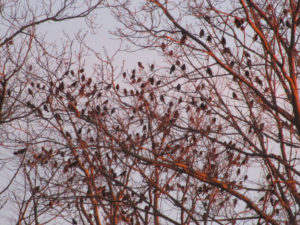
A starling murmuration in Monmouth Junction, Middlesex County.
STARLINGS, NO. 2: From reading “Garden and Afield,” you may have correctly deduced I hate non-native species, especially highly invasive ones. Not only do I find starlings, ” Sturnus vulgaris,” oily- and ugly-looking, they are non-native invasives. According to Cornell University’s All About Birds website, “All the European Starlings in North America descended from 100 birds set loose in New York’s Central Park in the early 1890s. The birds were intentionally released by a group who wanted America to have all the birds that (William) Shakespeare ever mentioned (in his writing). It took several tries, but eventually the population took off. Today, more than 200 million European Starlings range from Alaska to Mexico, and many people consider them pests.” The first thing we do, let us kill the starlings!
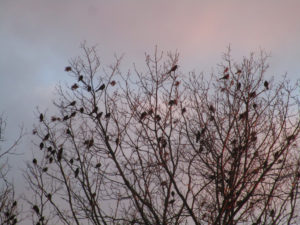
The Monmouth Junction starlings.
DAYLIGHT SAVINGS TIME: Daylight Savings Time begins Sunday, March 11, at 2 a.m. Spring forward with spring, so set the clocks one hour forward.
SUNRISE/SUNSET: DAYLIGHT SAVINGS TIME BEGAN SUNDAY, MARCH 11, AT 2 A.M.; SET THE CLOCKS ONE HOUR FORWARD. From Sunday, March 11, to Saturday, March 17, St. Patrick’s Day, the sun will rise about 7:15 to 7:05 a.m. and set about 7:00 to 7:05 p.m. From Sunday, March 18, to Saturday, March 24, the sun will rise about 7:05 to 6:55 a.m. and set about 7:10 to 7:15 p.m.
FULL MOON: The next full moon is March 31.
The March 4 moon, as seen through my living room window, waning from the March 1 full moon.
WEATHER: The National Weather Service forecasting office serving the Jersey Midlands is at http://www.weather.gov/phi/.
SPRING WILDFIRE SEASON: The Pine Barrens spring wildfire season generall runs from March 15 to May 15, when winds blow, humidity decreases, temperatures rise, and sun penetrates the essentially leafless forest, warming and drying the duff.
UPCOMING:
March 11, Sunday, 11 a.m. to 4 p.m., Atlantic County: 13th Annual Lines on the Pines, a Pine Barrens day of the written word, spoken word, art, and the performing arts at Stockton University, 101 Vera King Farris Drive, Galloway, 08205. More information at http://www.linesonthepines.org/linesonthepines.html.
April 9 to 15, Monday to Sunday, Mercer County: The annual Princeton Environmental Film Festival. Stand by for the specific schedule. This is a great event — not only showing environmental films, but some that are rather obscure. I try to go every year.
ME BAD OR ME GOOD? I blew off the Saturday, March 10, 29th Annual Pinelands Short Course to finish this week’s “Garden and Afield.” So, I wasted $50 and lost some knowledge. But as musician-singer-songwriter-friend Frank Pinto has noted, It is better to perform than to watch someone else perform. I am torn. In my early journalism days, I thought it was more important to write than read. Now, in my 40th year of journalism and my often tired state, I wonder….
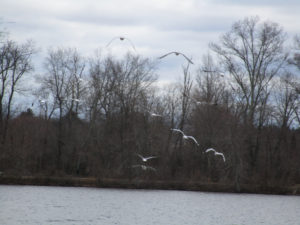
Gulls at Lake Carnegie on the boundary of Mercer, Middlesex, and Somerset counties.
Joe Sapia, 61, is a lifelong resident of Monroe — in South Middlesex County, where his maternal family settled more than 100 years ago. He is a Pine Barrens naturalist and an organic gardener of vegetables and fruit, along with zinnias and roses. He loves the Delaware River north of Trenton and Piedmont, too.
He draws inspiration on the Pine Barrens around Helmetta from his mother, Sophie Onda Sapia, who lived her whole life in these Pines, and his Polish-immigrant grandmother, Annie Poznanski Onda.
He gardens the same backyard plot as did his Grandma Annie and Italian-American father, Joe Sr. Both are inspirations for his food gardening. Ma inspires his rose gardening.
Joe is a semi-retired print journalist of almost 40 years. His work also is at @JosephSapia on Twitter.com, along with Facebook.com on the Jersey Midlands page.
Copyright 2018 by Joseph Sapia
Article and photos by Joe Sapia
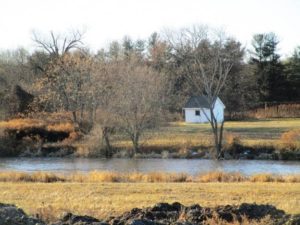
A farm outbuilding in Hopewell Township, Mercer County.
UPPER MILLSTONE RIVER EAGLE NEST: Last year’s pair of bald eagles, “Haliaeetus leucocephalus,” has returned to its nest along the Millstone River corridor on the boundary of Middlesex and Mercer counties. Last year, the nest fledged one eaglet. The state Endangered and Non-Game Species Program (within the Department of Environmental Protection’s Division of Fish and Wildlife) has named Anne Price, a professional naturalist and fellow Monroe, Middlesex County, resident, and me as the volunteer monitors for the nest. The eagles were still in pre-nesting phase, but we expect an egg or eggs to be laid any day now. More good news to follow next week. (In the 2017 state eagles report, http://www.state.nj.us/dep/fgw/ensp/pdf/eglrpt17.pdf, this nest is listed as No. 184.)
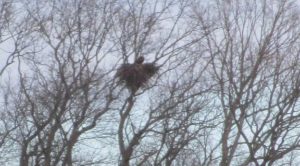
A bald eagle perched on the Upper Millstone River nest on the boundary of Mercer and Middlesex counties. This pair appears ready to lay an egg or eggs soon.
SNOWFALL: The Wednesday, January 17, snowfall in the part of Monroe between Jamesburg and Helmetta, Middlesex County, was about 1.0 inches, bringing the seasonal total to about 17.0 inches. (The seasonal average, measured at New Brunswick about 7.5 miles away, is 25.8 inches. So, we need only about 9 more inches to hit the average and we have about 3 months of snow time left.)
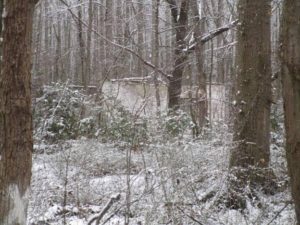
Snowy woods with an abandoned building on Federal Road in Monroe, Middlesex County.
SNOWFENCING: I have talked about snowfencing in open areas before and how it prevents drifting on roadways. Also, I have posted photos. But, perhaps, the post-snowfall scene best describes snowfencing, how snow is deposited on the downwind side. A photograph of the post-snowfall scene:
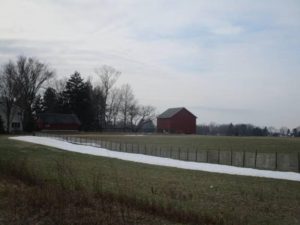
Here, on Main Street in Cranbury, Middlesex County, snow has deposited on the downwind side of the snowfencing. This same concept is used to contain blowing sand on beaches.
CANADA GEESE: I have been seeing a lot of Canada geese, “Branta canadensis,” on farmland, presumably helping themselves to leftover field corn in these fields. And I keep an eye out to see if there is anything else mixed in with these Canadas, perhaps a snow goose, “Chen caerulescens.”
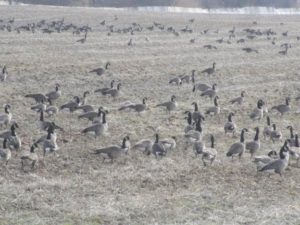
Canada geese on farmland in Cranbury, Middlesex County.

Canada geese flying in Hopewell Township, Mercer County.
BIRDS AROUND THE YARD: We have an incredible world of nature around us in New Jersey. We are at a prime location, where northern and southern animal and plant species meet. One easy thing to do is take time to view the birds in one’s yard. I feed them, using sunflower kernels/hearts nyger. (Last year, though, I stopped feeding birds in the summer, letting them serve as a natural pesticide in my yard. This year, I may extend this feeding ban beyond June, July, and August to a greater gardening period.)
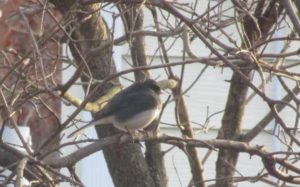
It is a “snowbird” – or dark-eyed junco, “Junco hyemalis” – but it is bundled up against the cold. This junco, in an oak, genus “Quercus,” in my sideyard, has its feathers fluffed to protect it against the cold.
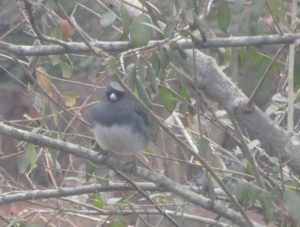
This photograph shows the “dark-eyed” in this dark-eyed junco. This bush in front of my living room window is a fun place to watch birds.
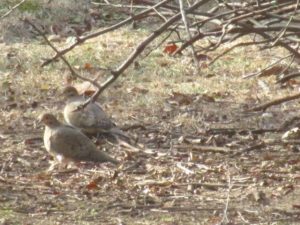
Mourning doves, “Zenaida macroura,” huddled under the flowering quince bush in my backyard.
COASTAL PLAIN BODIES OF WATER: The Jersey Midlands is divided into two geological provinces – the rolling and rocky Piedmont to the west and the flatland, either sandy or gravely, to the east. (The Coastal Plain can be divided into the Outer, or sandy, white soils of the Pine Barrens and beach, and the Inner, the darker, gravely soil conventional farming areas. For the sake of this story, we will talk of the Coastal Plain as one province.) Because of its flatness, there are few, if any, natural bodies of water on the Coastal Plain; Instead, they are human-made, often by dams holding back waterways. In Middlesex County, on the boundary of Helmetta, Monroe, and Spotswood, there is now-dry Lake Marguerite. It was formed by the damming of Manalapan Brook, but has been dry since the 1920s or so. The other day I shot photographs of its old dam.

The remnant of the Lake Marguerite dam on Daniel Road-10th Street on the boundary or Spotswood and Monroe, Middlesex County.

The circa 1906-1907 Lake Marguerite dam.
“OLD JERSEY”: As the Jersey Midlands develop, I am glad to run across “Old Jersey” remnants. Across the street from my house is one of them with an environmental twist – a “Prevent Forest Fires” sign. This sign might be the same one I have seen over all my 61 years. (Just to point out: There has been a different way of thinking on fire. For example, fire is good for the ecology of the Pine Barrens, such as where I live; But it is bad for people.)
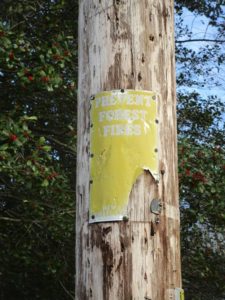
An old “Prevent Forest Fires” sign in my Monroe, Middlesex County, neighborhood.
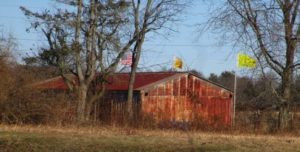
Another “Old Jersey” scene: a farm in Hopewell Township, Mercer County.
SKY VIEWS: This week’s sky views are from Monroe, Middlesex County, and the Manalapan-Freehold Township boundary, Monmouth County.

Monmouth Battlefield State Park on the boundary of Freehold Township and Manalapan, Monmouth County.

Monroe, between Applegarth and Wyckoff’s Mills.
ATLANTIC OCEAN TEMPERATURES: The Atlantic Ocean temperature in New Jersey ranged from about 36 to 37 degrees.
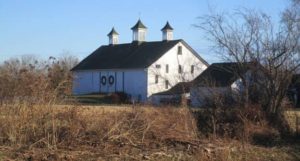
More farming from Hopewell Township Mercer County.
WEATHER: The National Weather Service forecasting office serving the Jersey Midlands is at http://www.weather.gov/phi/.
SUNRISE/SUNSET: For Sunday, January 21, to Saturday, January 27, the sun will rise about 7:10 to 7:15 a.m. and set about 5:05 to 5:10 p.m. For Sunday, January 28, to Saturday, February 3, the sun will rise about 7:05 a.m. to 7:10 a.m. and set about 5:10 p.m. to 5:20 p.m.

The crescent moon over Helmetta Pond, Middlesex County. The crescent moon is waxing toward the January 31 Full Snow Moon.

Ralph “Rusty” Richards, 85-years-old, a mentor of mine in the Pine Barrens around Helmetta, was buried this week in St. James Cemetery in the part of Monroe between Helmetta and Jamesburg, Middlesex County. As his obituary read, “He was an avid woodsman with an extensive knowledge of the local pine barrens….” I left this bough of pitch pine, “Pinus rigida,” the most common pine in the New Jersey Pine Barrens, on Rusty and his wife’s, Mona’s, gravestone. The cemetery is in my neighborhood and Rusty’s grave is a neighbor of my parents’s, Joe Sr. and Sophie Onda Sapia’s, grave. (My maternal family, the Onda-Poznanski family, has known the Richards family for 100 or so years.)
— Joseph Sapia
2018, January 21, Sunday,
A woodsman of the Pine Barrens of Helmetta
Joe Sapia, 61, is a lifelong resident of Monroe — in South Middlesex County, where his maternal family settled more than 100 years ago. He is a Pine Barrens naturalist and an organic gardener of vegetables and fruit, along with zinnias and roses. He draws inspiration on the Pine Barrens around Helmetta from his mother, Sophie Onda Sapia, who lived her whole life in these Pines, and his Polish-immigrant grandmother, Annie Poznanski Onda. He gardens the same backyard plot as did his Grandma Annie and Italian-American father, Joe Sr. Both are inspirations for his food gardening. Ma inspires his rose gardening. Joe is a semi-retired print journalist of almost 40 years. His work also is at @JosephSapia on Twitter.com, along with Facebook.com on the Jersey Midlands page.
Copyright 2018 by Joseph Sapia
Article and photos by Joe Sapia (except where noted)

The Delaware River, iced-over Tuesday, January 2, at Washington Crossing — looking from Mercer County, New Jersey, to Bucks County, Pennsylvania, just upstream of the bridge.
SUB-FREEZING DAYS: After days of sub-freezing cold, how cold was it? Cold enough for a waterway – in this case, the mighty Delaware River — to freeze over.

The frozen-over Delaware River Tuesday, January 2, at Washington Crossing, looking from Pennsylvania to New Jersey.

A woman maneuvers Main Street in Cranbury during the Thursday, January 4, snowfall.
SNOWFALL, JANUARY 4: This storm produced a wind-whipped, powdery snow. Snowfall totals reported by National Weather Service:
Burlington County: 3.4 inches at Cinnaminson to 7.5 inches in the Southampton area.
Hunterdon County: 1.9 inches at Readington to 5.8 inches in the Hampton area.
Mercer County: 4.0 inches in the Washington Crossing area to 6.6 inches in the Lawrence area.
Middlesex County: 4.5 inches in the South Brunswick area to 9.6 inches at Cheesequake.
Monmouth County: 9.0 inches at Keyport to 18.0 inches in the West Long Branch area.
Ocean County: 12.5 inches in the Brick area to 18.3 inches in the Berkeley area.
Somerset County: 3.0 inches in the Montgomery area to 5.8 inches in the Franklin area.
(These totals are for these specific stations and may not be complete highs and lows for the counties.)

A snowplow pushes snow on Stockton Avenue in Jamesburg, Middlesex County, in the Thursday, January 4, snowfall.
SNOWFALL FOR THE SEASON: With the January 4 snowfall, my house in Monroe, Middlesex County, has had 16 inches of snow, so far this season. The seasonal average at New Brunswick, Middlesex County, or about 7.5 miles from my house, is 25.8 inches. The January 4 snowfall produced 7 inches at my house.

A wind-whipped, snowy field in Monroe, Middlesex County.
WALKING THE SNOWY WOODS: During the Thursday, January 4, storm, I set out from my house about 4:30 p.m., hitting the woods across the street, not wanting to pass up the pristine snowy woods. It was a brief walk, only about 45 minutes from shortly before sunset to shortly after. But I was glad I got to spend a few minutes shooting pictures of nature’s beauty and relaxing in the woods, before shoveling snow. (Weather conditions: Overcast, estimated temperature of 27 degrees, dew point of 5.5 to 6, wind sounding like a freight train.) I got thinking about this short time in the woods. Normally, I do not consider it a hike unless I do at least 3 miles. Perhaps I should re-focus and think about the mental part of the woods and try to get out there daily, even if for only a short time.
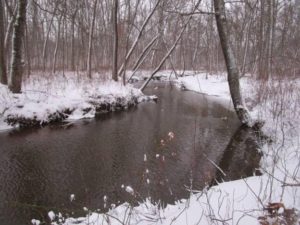
The Old Swimming Hole on Manalapan Brook in Monroe, Middlesex County.
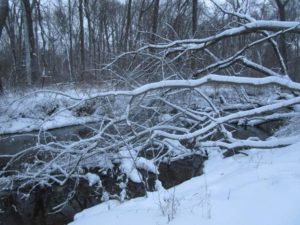
A snow-covered treefall on Manalapan Brook in Monroe, Middlesex County.
SNOW AND THE LAY OF THE LAND: Take advantage of any snow cover. Where there is no snow cover, the woods presents itself as a homogenous picture of earth tones or green leaves – or both. But add a snow-cover; or, better, snow-cover and snow clinging to vegetation; or better yet, snow-cover, snow clinging to vegetation, and foliage and the depth and roll of the land stand out.

The snow-dusted Pine Barrens around Helmetta, Middlesex County – here, specifically, an East Brunswick section of the Jamesburg Park Conservation Area. With the snow contrasting against the earth tones of the woods, it is easy to see the roll of the land.
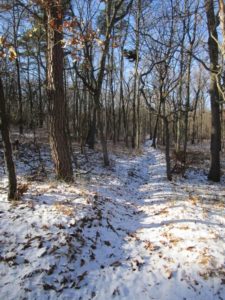
A firecut, plowed by the state Forest Fire Service before a controlled burn here in the Jamesburg Park Conservation Area, is easly seen, along with the rest of the lay of the land, thanks to snow contrasting with the woods’s earth tones.
VOICES FROM AFIELD, EAGLE: Patty Byrnes Lang of Monroe, Middlesex County, checked in with photographs of a bald eagle, “Haliaeetus leucocephalus,” she saw on the boundaries of Monroe, Cranbury/Middlesex County, and East Windsor/Mercer County. In New Jersey, bald eagles are “endangered,” or in immediate jeopardy, as breeders and “threatened,” meaning if conditions persist they could become endangered,” in general. Patty described one encounter, “I caught a glimpse of him in one of the trees on the left. We got to watch as he flew off the branch he was on, circled the field, and landed on another tree.” Based on its coloring, this is an adult. It could be one of the adults that had a nest last year nearby, along the Millstone River in Monroe. This is the time of year eagles begin working on nests.
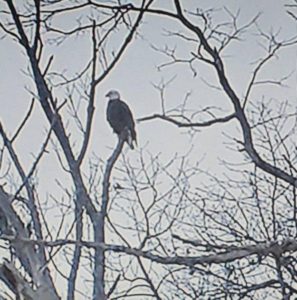
A bald eagle on the boundary of Middlesex and Mercer counties, along the border of Monroe/Middlesex, Cranbury/Middlesex, and East Windsor/Mercer. (Photo copyright 2017 by Patty Byrnes Lang)
VOICES FROM AFIELD, BLUEBIRD: Bob Kane of Cranbury, Middlesex County, checked in with a photograph of an eastern bluebird, “Sialia sialis,” taken in his town. This one is easily identifiable as a male, because of the bright coloring.

A male eastern bluebird at Cranbury, Middlesex County. (Photo copyright 2018 by Bob Kane)
RANCOCAS CREEK: The Rancocas Creek watershed is 360 square miles. It is the only major waterway that flows into the Delaware River from the Pine Barrens. And, despite being freshwater, has a tidal effect; The Delaware River has a tidal effect on its freshwater as far north as Trenton.

Low tide on Rancocas Creek, looking upstream on the boundary of Mount Laurel, Willingboro, and Westampton, all in Burlington County. Although this is freshwater, there is a tidal effect on the Delaware River and its tributaries as far north as Trenton.

Rancocas Creek, looking downstream at the boundary of Mount Laurel, Willingboro, and Westampton, all Burlington County.
GARDEN WRITING COURSE: This spring, I will be teaching non-fiction writing again at the Princeton Adult School. This time, it will be “Garden Writing,” five sessions on Thursdays, 7 p.m. to 9 p.m., from March 22 to April 26. The class description: “Look at your garden and yard in a different way – through your words. Record your memories in the garden and yard through the essay and vignette. This writing-intensive course has weekly take-home assignments, with the instructor returning critiqued papers. Students will learn writing components, outlining, grammar, style, interviewing, and the importance of resources such as dictionaries and stylebooks – with all assignments focusing on our vegetables, flowers, yards – or afield, if you wish. In-class discussion will cover good examples turned in by students, common problems, and concerns. Feel free to use the class to write a chapter a week of a dream project, work on getting published, keep a journal, or just have fun.” The class costs $99. Enrollment at http://www.ssreg.com/princeton/classes/classes.asp?catID=3679.
ATLANTIC OCEAN TEMPERATURES: The Atlantic Ocean temperature at in New Jersey on the January 6-7 weekend ranged from about 29 to 30 degrees.
WEATHER: The National Weather Service forecasting office serving the Jersey Midlands is at http://www.weather.gov/phi/.
SUNRISE/SUNSET: For Sunday, January 7, to Saturday, January 13, the sun will rise about 7:20 a.m. and set about 4:45 to 4:50 p.m. For Sunday, January 14, to Saturday, January 20, the sun will rise about 7:15 to 7:20 a.m. and set about 4:55 to 5 p.m.
PENNSYLVANIA FARM SHOW: The Pennsylvania Farm Show continues through Saturday, January 13. It is a real-deal show of farming life, not faux farming. So, it has animals, tractors, food preparation, food to buy, gardening displays, and exhibitions. Visitors can get up close to it all. And check out the butter sculpture! (Unfortunately, I will miss the show this year. I had plans to go Wednesday with friends Jimmy and Kathy Krygier of Krygier’s Nursery in South Brunswick, Middlesex County, but work called. I am disappointed, because I look forward to this show.) More information at http://www.farmshow.pa.gov.
COVERING THE WEATHER: During my 31 years as a reporter at the Asbury Park Press, I never saw fellow Metro reporters whine so much about covering something than about weather stories. Me, just the opposite. I loooooooved weather stories. Still do. Was out most of Thursday, January 4, chasing the snow.

Joey on the job, here Tuesday, January 2, photographing the iced-over Delaware River at Washington Crossing, Mercer County.. (Photo copyright 2018 by Pamela B. Roes)
Joe Sapia, 61, is a lifelong resident of Monroe — in South Middlesex County, where his maternal family settled more than 100 years ago. He is a Pine Barrens naturalist and an organic gardener of vegetables and fruit, along with zinnias and roses. He draws inspiration on the Pine Barrens around Helmetta from his mother, Sophie Onda Sapia, who lived her whole life in these Pines, and his Polish-immigrant grandmother, Annie Poznanski Onda. He gardens the same backyard plot as did his Grandma Annie and Italian-American father, Joe Sr. Both are inspirations for his food gardening. Ma inspires his rose gardening. Joe is a semi-retired print journalist of almost 40 years. His work also is at @JosephSapia on Twitter.com, along with Facebook.com on the Jersey Midlands page.
Copyright 2017 by Joseph Sapia
Article and photos by Joe Sapia

Soft morning sunlight contrasts with threatening skies at the high ground of Thompson Park in Monroe, Middlesex County.
A popular winter activity for generations at Thompson Park is sledding from the high ground toward the low ground around “Jamesburg Lake” (properly Lake Manalapan). The 30-acre lake is formed by the damming of Manalapan Brook at Jamesburg. Remember, there are few, if any, natural bodies of water on the Coastal Plain.

Sledding at Thompson Park in Monroe, Middlesex County, via my 2001 folk art Christmas card.
SNOWFALL: The Saturday, December 30, snowfall of 1.0 inch at my house in the part of Monroe between Helmetta and Jamesburg, Middlesex County, brought the season’s total to 9.0 inches. The seasonal average for New Brunswick, Middlesex County, about 7 miles away, is 25.8 inches. Elsewhere in the Midlands, according to the National Weather Service, with these readings based on what had been reported by reliable spotters at the end of the snowfall and perhaps not comprehensive: Burlington County: a high of 2.5 inches at Florence to a low of 1.5 inches at Moorestown; Hunterdon County: 1.0 inch in Lebanon to .8 inches at Whitehouse Station; Mercer County: 3.2 inches in Hamilton to 2.5 inches in Ewing; Monmouth County: 2.8 inches in the Howell area to .9 inches in Shrewsbury; Somerset County: 1.0 inch in Basking Ridge to .8 inches in Bridgewater; Ocean County: 3.3 in Jackson to 1.5 inches in Toms River.
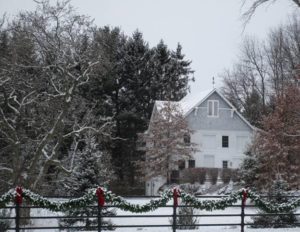
Main Street in Cranbury, Middlesex County, in the Saturday, December 30, snowfall.
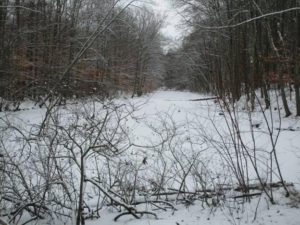
Iced-over and snow-covered Devil’s Brook on the boundary of Plainsboro and South Brunswick, Middlesex County.
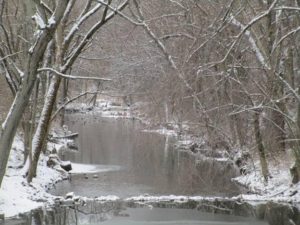
Cranbury Brook as it drains Brainerd Lake (“Cranbury Lake’) in Middlesex County.
SAFE ICE: This time of year, and especially in the hard freeze the Jersey Midlands is in the midst of, we may be tempted to walk out on ice or go skating on it. Be careful! My rule of thumb is the ice must be at least 4-inches-thick. But various factors could come into play, such as warming temperatures, honey-combing, and running water. So, additionally, I look for crystal clear ice or blue-white ice. I am careful of melting ice, snow insulating ice, channels that may run through bodies of water, and fragile ice where water meets land or vegetation.
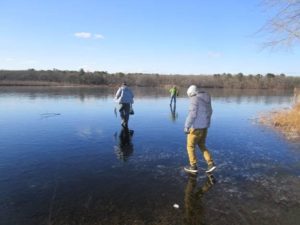
Anglers on an iced-over Helmetta Pond.
ICE SAFETY: If ice is breaking underneath, displace your weight by lying flat. For would-be rescuers, follow this order: throw (a line or flotation device), row (a boat to the person), go (yourself only as a last resort). Probably the soundest advice is to immediately seek help from expert rescuers.

Prospertown Lake in Jackson, Ocean County. The lake is at the northern extreme of the main Pine Barrens.
SWAMP-WALKING: With the sub-freezing high temperatures for an extended period, this is what I look for — a good freeze of the swamps, allowing access to otherwise difficult places to get to. I love swamps!
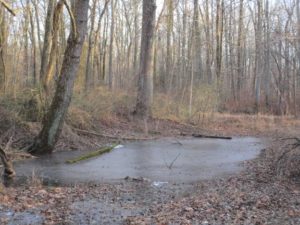
An iced-over wet area in the Manalapan Brook floodplain in Monroe, Middlesex County.
SWAMP-WALKING, No. 2: I started off into the woods across the street from my house – in the Pine Barrens of Monroe, Middlesex County – to do some swamp-walking in the Manalapan Brook floodplain. I did do some, but I got sidetracked when I noticed the abundance of winterberry, genus “Ilex.” I did not get around to making a Christmas wreath or swag, which I decorate with winterberry, but I wound up gathering winterberry to display on its own. I came home with a nice bundle. (To conserve, I broke only one branch from each selected bush.)

Winterberry from the swamp hardwood forest of the Manalapan Brook floodplain on display on my antique kitchen table.
SNOW GEESE: I finally saw some snow geese, “Chen caerulescens,” down from the Arctic as I was driving along the Mercer County-Middlesex County boundary on the border of East Windsor, Cranbury, and Monroe. They were easy to identify by their white bodies and black-tipped wings. There were only a few, rather than a flock. I took a few minutes to see if they were joining a flock on some farmland, but I was going to work and had limited time, finding nothing in my quick search.
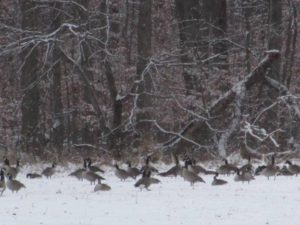
Canada geese, “Branta Canadensis,” is a snow-covered field in South Brunswick, Middlesex County.
ATLANTIC OCEAN TEMPERATURES: The Atlantic Ocean temperature at Sandy Hook on December 30-31 weekend ranged from about 30 to 35 degrees.

A quiet December Atlantic Ocean beach, looking from Avon-by-the-Sea to Asbury Park, Monmouth County.
MOON: The next full moon, the Full Moon After Yule, is January 1, New Year’s Day.

The near-full moon over the swamp hardwood forest of the Manalapan Brook floodplain in Monroe, Middlesex County.
SUNRISE/SUNSET: For Sunday, December 31, to Saturday, January 6, the sun will rise about 7:20 a.m. and set about 4:35 to 4:40 p.m. For Sunday, January 7, to Saturday, January 13, the sun will rise about 7:20 a.m. and set about 4:45 to 4:50 p.m.
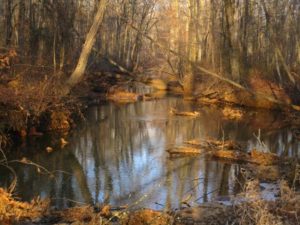
Soft sunlight on Manalapan Brook in Monroe, Middlesex County, as it flows toward Helmetta and Spotswood, also in Middlesex County.
Joe Sapia, 61, is a lifelong resident of Monroe — in South Middlesex County, where his maternal family settled more than 100 years ago. He is a Pine Barrens naturalist and a gardener of organic vegetables and fruit, along with zinnias and roses. He draws inspiration on the Pine Barrens around Helmetta from his mother, Sophie Onda Sapia, who lived her whole life in these Pines, and his Polish-immigrant grandmother, Annie Poznanski Onda. He gardens the same backyard plot as did his Grandma Annie and Italian-American father, Joe Sr. Both are inspirations for his food gardening. Ma inspires his rose gardening. Joe is a semi-retired print journalist of almost 40 years. His work also is at @JosephSapia on Twitter.com, along with Facebook.com on the Jersey Midlands page.
Copyright 2017 by Joseph Sapia
Article and photos by Joe Sapia
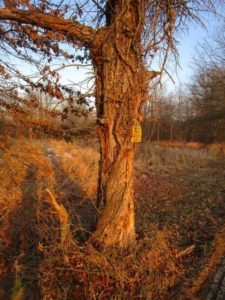
Soft, end-of-the-day sunlight bathes this tree and field on the Pennington-Hopewell Township border, Mercer County. Notice the thick vine – poison ivy, “Toxicodendron radicans” – climbing the tree.
DRIVE-BY NATURALIST, GREAT BLUE HERON: As I was passing Carnegie Lake, which is in the area of Princeton, Mercer County, and Kingston, Somerset-Middlesex counties, I figured I would shoot a photograph of the winter-quiet lake. Quiet? Wrong! As I arrived, a great blue heron, “Ardea herodias,” flew from left to right, landing at the lake. I heard a squawk or squawks, with this heron and another confronting each other, perhaps because these solitary hunters of fish and other aquatic life did not want to share a territory. One flew off, while the other stayed put, providing a subject for my photographs.

As I arrived at Carnegie Lake on the Princeton, Mercer County-Kingston, Middlesex-Somerset counties border, a great blue heron flew in.
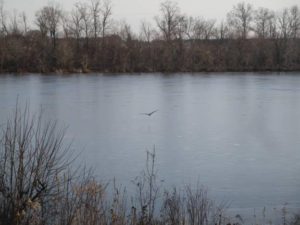 Then, there was a confrontation between two great blues, with one flying off.
Then, there was a confrontation between two great blues, with one flying off.

Remaining was one blue heron, who cooperated nicely for photographs.

As for the winter calm of Carnegie Lake, it, otherwise, was there.
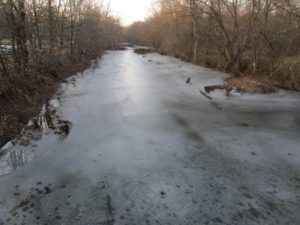
STONY BROOK: Stony Brook meanders for about 22 miles from the Ringoes area of Hunterdon County to the Princeton area of Mercer County, where it empties into the Millstone River. The brook drains approximately 65 square miles.
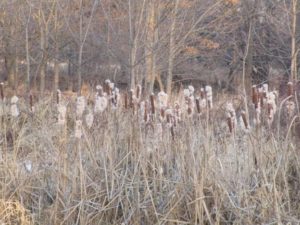
Punks, or cat-tails, genus “Typha,” with their fluffing-out seed heads, in the Stony Brook floodplain in the Pennington-Hopewell Township area, Mercer County.
IF YOU CANNOT GET TO THE ECOSYSTEM, BRING THE ECOSYSTEM TO YOU: Two geological provinces comprise the Jersey Midlands, the rolling hills and rocky Piedmont to the west and the flat, either gravelly or sandy, Coastal Plain to the east. Drive along the flat farmland on the Cranbury-Plainsboro border in Middlesex County and look west to the Princeton area hills in Mercer County, for example, and one would be looking from the Coastal Plain to the Piedmont. So, I was driving through the Pine Barrens around Helmetta and noticed a red shale pile of dirt, dumped on the side of the road in the Jamesburg Park Conservation Area, operated by the Middlesex County Parks and Recreation. Dumping! But this one takes the cake, the apparent dumping of Piedmont fill dirt in a sandy soil area of the Coastal Plain. Back up a truck alongside a road and dump fill dirt that you do not need! I take this as a personal affront because this is my home woods, which my maternal family has walked for more than 100 years, and in Jamesburg Park, where I am a volunteer of several years. The progress of dumping: litter to household debris to a different ecosystem!
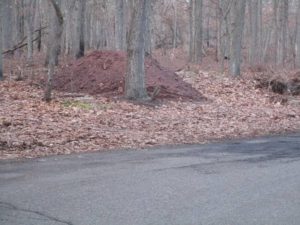
An illegally dumped pile of fill dirt, apparently Piedmont soil dumped in the Coastal Plain of the Pine Barrens around Helmetta, Middlesex County.
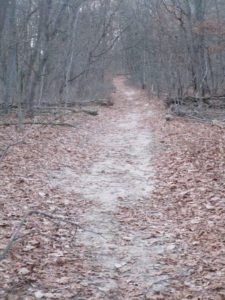
A Jamesburg Park Conservation Area trail of native white, sandy Pine Barrens soil near the dumped load of fill.
SNOW GEESE: I have not noticed any snow geese, “Chen caerulescens,” down from the Arctic. Bob Eriksen, a retired state Division of Fish and Wildlife biologist, checked in from just outside the Midlands in Warren County, saying, “Snow geese arrived, here, later than usual. Huge flocks came in overnight last Wednesday into Thursday morning December 13-14.”
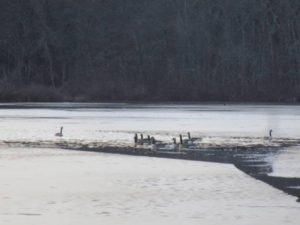
Canada geese, “Branta Canadensis,” on Helmetta Pond, Middlesex County.
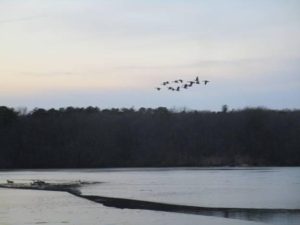
CANADA GEESE: I still stop to look at honking Canada geese, “Branta Canadensis,” in flight. And I get a bigger kick, perhaps, watching them land. While at Helmetta Pond, I noticed geese coming into the lake from the west, then swinging wide to the north and circling in for their landing. What a sight!
WINTER SOLSTICE: With the passing of the Winter Solstice on Thursday, December 21, daylight is increasing.
SNOWFALL TO DATE: To date, 8.0 inches at the Jamesburg-Helmetta area of Middlesex County. In this area, specifically New Brunswick, Middlesex County, the average seasonal total is 25.8 inches.
WEATHER: National Weather Service forecasting, along with other information, for the Jersey Midlands is at http://www.weather.gov/phi/.
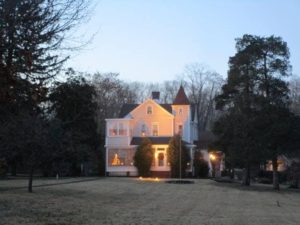
Merry Christmas from Helmetta. Here, the old Clemons house, one of the mansions associated in the 20th Century with the George W. Helme Snuff Mill — in this case, belonging to one of the mill’s upper level managers. According to house owner Carol Bohinski, “The Clemons mansion was built in 1890 by Arthur Clemons, brother-in-law to George W. Helme. Helme’s grandson, Arthur Helme Clemons, was a Helme Company President.”
Joe Sapia, 61, is a lifelong resident of Monroe — in South Middlesex County, where his maternal family settled more than 100 years ago. He is a Pine Barrens naturalist and a gardener of organic vegetables and fruit, along with zinnias and roses. He draws inspiration on the Pine Barrens around Helmetta from his mother, Sophie Onda Sapia, who lived her whole life in these Pines, and his Polish-immigrant grandmother, Annie Poznanski Onda. He gardens the same backyard plot as did his Grandma Annie and Italian-American father, Joe Sr. Both are inspirations for his food gardening. Ma inspires his rose gardening. Joe is a semi-retired print journalist of almost 40 years. His work also is at @JosephSapia on Twitter.com, along with Facebook.com on the Jersey Midlands page.
Copyright 2017 by Joseph Sapia
Article and photos by Joe Sapia
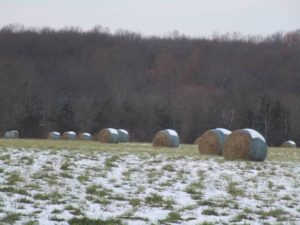
Fall meets winter with rolls of hay awaiting harvest on snow-covered farmland on the Princeton Ridge in Hopewell Township, Mercer County. The Princeton Ridge is one of three well-known pieces of hilly ground just north of downtown Princeton, the other two being Sourland Mountain and the Kingston Ridge.
SEASON’S FIRST SNOWFALL: My house in Monroe, Middlesex County, got its first snowfall of the season, this week – actually three snowfalls! The individual totals were December 9-10, Saturday-Sunday, 5.0 inches; December 13-14, Wednesday-Thursday, 1.5 inches; and December 15, Friday, 1.5 inches. All told, 8.0 inches. In my area, specifically New Brunswick, the average seasonal total is 25.8 inches.
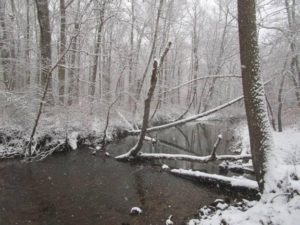 Snow falls along Manalapan Brook in Monroe, Middlesex County, during the season’s first snowfall, December 9-10, Saturday-Sunday. This locale is only a few hundred feet from my front door and I remember walking to this part of “The Brook” with my father when I was about 4-years-old, or more than 55 years ago.
Snow falls along Manalapan Brook in Monroe, Middlesex County, during the season’s first snowfall, December 9-10, Saturday-Sunday. This locale is only a few hundred feet from my front door and I remember walking to this part of “The Brook” with my father when I was about 4-years-old, or more than 55 years ago.
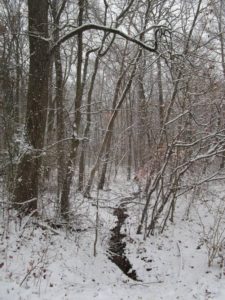
A stream cuts its way through the Manalapan Brook floodplain in Monroe, Middlesex County, during the first snowfall, December 9-10, Saturday-Sunday. This locale, at the bottom of my street, is what I have always known as “The Swamp.”
SNOWFENCING: As we travel through the Jersey Midlands, we may see snow-fencing in place to prevent drifting across roadways. The idea is to get the fencing up before it snows and hope it does not snow after farmers need to get in their fields for spring plowing or, that is, before it ends snowing for the season.
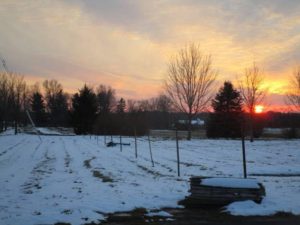
In Hopewell Township, Mercer County, this snow-fence was not up in time for the December 9-10, Saturday-Sunday, snowfall. Stakes in place, yes. Actual fencing, no.
GEMINID METEOR SHOWER: The Geminid Meteor Shower on the Wednesday-Thursday, December 13-14, overnight was a washout for me because of cloudy skies. More disappointing, because during that overnight, I was driving home from Baltimore and was hoping to be entertained for 2-1/2 to 3 hours. But that was a snowy night, so the viewing was not to be. Did anybody get lucky and see meterors?
‘SNOWBIRDS’ IN THE GARAGE: As I work in the yard or go between my house and my Jeep, I often leave the garage doors open. Occasionally over the years, I find a bird in the garage – seemingly always a “snowbird,” or dark-eyed junco, “Junco hyemalis,” birds that travel from as far away as Canada to stay from fall to spring. Most recently, I found one in the garage this week. Why seemingly always a snowbird in the garage? I do not know. Any thoughts?

A snowbird sits on top of my backyard birdfeeder while snow falls Friday, December 15, in Monroe, Middlesex County. American holly, “Ilex opaca,” is in the foreground.
AROUND THE BACKYARD: I sitting at my desk, in a corner room with windows facing north from the side of the house and facing west into the backyard, when I heard a wheezing call. A hawk? I looked into the backyard and saw no birds around the feeder or elsewhere in the backyard. However, I did notice a squirrel, “Sciurus carolinensis,” on the pole holding the feeder. The squirrel was frozen in place, facing downward, or in fleeing position. Yes, I thought, that probably was a hawk I heard. When the predator is around, the lucky prey flees.
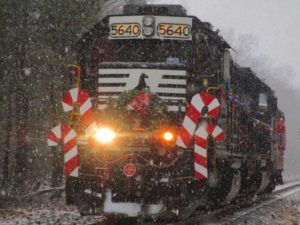
The annual ConRail Santa Train rumbled through Monroe, Middlesex County, this time while it is snowing December 9, Saturday. The Santa Train is especially fulfilling to me because it is a tradition of about 35 years; passes on railroad tracks my family has lived along for more than 100 years, as close as bordering the property and as far as my house, a quarter-mile; and, I have loved the freights on this line since my childhood days of the mighty Pennsylvania Railroad. It passes on the former line of the Camden-Amboy Railroad, the first railroad in the country, in the early 1830s, to replace equine power with mechanical power.
VOICES FROM AFIELD, CHRISTINE DENNELER: Christine Denneler, one of my Pine Barrens mentors over the last 35 years, checked in, regarding hunting: “Since most of my husband’s family is gone, hunting is not talked about at the holiday table as it was in the old days. (Late husband) Bill was not an avid hunter as was his grandpop, but he and his father liked the camaraderie.” (Chris has been a backbone of hiking in the Outdoor Club of South Jersey, www.ocsj.org, for decades. To go on a Chris Denneler hike is to learn the Pine Barrens.)
TONY’S FARM AND GARDEN CENTER: I was driving home from South Jersey and took advantage of passing Tony’s Farm and Garden Center — started and run by the Ciaccio family in Robbinsville, Mercer County, since 1946 — by stopping in. I have been patronizing Tony’s – in my case, for houseplants, vegetable plants, and garden supplies – for decades. It is one of my favorite places in the Jersey Midlands. Not only was it holding on to the 2017 gardening season, but it was decked out for Christmas. So, I bought a Christmas cactus – my first shot at one, so let us see if I can keep it alive – and two devil’s ivy houseplants – which even I have a hard time killing. (A shout-out to Ciaccio family members, especially young Tony, for their quality products and service and friendliness. Tony’s is one of my main sources for gardening information.)

Wreaths at Tony’s Farm and Garden Center in Robbinsville, Mercer County.

Poinsettias at Tony’s Farm and Garden Center

Christmas cactuses at Tony’s Farm and Garden Center.
VOICES FROM AFIELD, PRISCILLA “PEPPY” BATH: Outdoorswoman Priscilla “Peppy” Bath checked in on hiking Jake’s Branch County Park in the Ocean County Pine Barrens: “I have never before been to the park and it is beautiful with many well-marked trails. We hiked the Blue (Trail) 4-mile hike. Alongside of the trail were many patches of trailing arbutus (“Epigaea repens”) and also turkey beard (“Xerophyllum asphodeloides”). Neither was in bloom, but I will go back in the spring and see the beautiful flowers.” More information on Jake’s Branch Park is available at http://www.oceancountyparks.org/ContentPage.aspx?ID=0694b294-986f-46e6-a679-d03ac775c176.
‘SNOW GEESE’: This time of year, we can expect to see snow geese, “Chen caerulescens,” down from the Arctic tundra – perhaps flying by, noticeable by their white color and black-tipped wings, or in farm fields. So far, I have not seen any, but hope to. (The species also has a dark version, or the “blue goose.”)

I took this photo of snow geese a few years ago on farmland along the Cranbury-Plainsboro boundary in Middlesex County. Here, their white bodies and black wingtips, which provide easy identification, are easily seen.
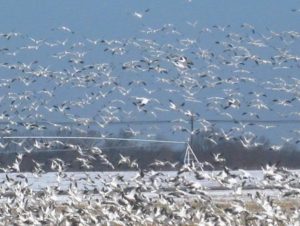
Another photograph of snow geese from a few years ago. Here, both in flight and in a cornfield.
TUNDRA SWANS: Tundra swans, “Cygnus buccinators” – New Jersey’s only native swan — are in the area. They, too, are cold-weather visitors from the Arctic tundra. My favorite place to see them is Whitesbog, in the main Pine Barrens and part of Brendan T. Byrne State Forest. Here is a story about Tundra Swan No. 207, spotted this season at Whitesbog, http://birdquiz.net/t207-2017/.
THE QUIET OF WINTER: In the winter, with many people staying inside in the warmth, the outdoors has a quiet solitude in many spots. Two places I visited during the week come to mind, the Delaware and Raritan Canal, where I visited the canal in Franklin Township, Somerset County, and the confluence of Crosswicks Creek and the Delaware River at Bordentown City, Burlington County.

The Delaware and Raritan Canal at Griggstown in Franklin, Somerset County.

Crosswicks Creek at Bordentown City, Burlington County.
ATLANTIC OCEAN TEMPERATURES: The Atlantic Ocean temperature at Sandy Hook on December 17, Sunday, ranged from about 36 to 40 degrees.
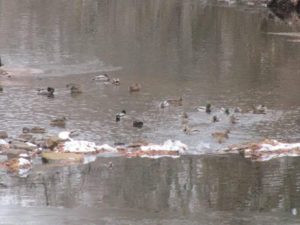
Mallard ducks, “Anas platyrhynchos,” on Cranbury Brook in Cranbury, Middlesex County.

A familiar sound is the honking, then sighting, of Canada geese, “Branta Canadensis,” I captured this photograph from my backyard in Monroe, Middlesex County.
SUNRISE/SUNSET: For Sunday, December 17, to Saturday, December 23, the sun will rise about 7:15 to 7:20 a.m. and set about 4:25 p.m. For Sunday, December 24, to Saturday, December 30, the sun will rise about 7:20 a.m. and set about 4:35 to 4:40 p.m.
WINTER SOLSTICE: The Winter Solstice, or the day with the least amount of daylight, is December 21, Thursday. The sun rises about 7:17 a.m. and sets about 4:35 p.m. After, the amount of daylight grows until June 21, the “longest day” of the year.
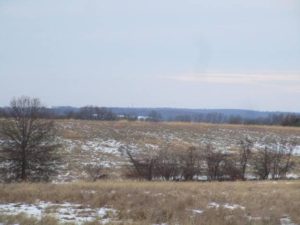
A view of Sourland Mountain, which is on the boundary of Somerset, Mercer, and Hunterdon counties, in the background across the farmland. This is as seen from the Princeton Ridge, Mercer County.
WEATHER: National Weather Service forecasting, along with other information, for the Jersey Midlands is at http://www.weather.gov/phi/.
UNEXPECTED WILDLIFE REFUGE SEEKS VOLUNTEERS: Our friends at the Unexpected Wildlife Refuge, just south of the Jersey Midlands in Gloucester County, seek volunteers to patrol the property to keep hunters off until at least the end of January. If interested, contact the refuge, http://unexpectedwildliferefuge.org/.
 Snow clings to an American holly, “Ilex opaca,” in my backyard in Monroe, Middlesex County, from the December 9-10, Saturday-Sunday. This was the first snowfall of the season at my house.
Snow clings to an American holly, “Ilex opaca,” in my backyard in Monroe, Middlesex County, from the December 9-10, Saturday-Sunday. This was the first snowfall of the season at my house.
Joe Sapia, 61, is a lifelong resident of Monroe — in South Middlesex County, where his maternal family settled more than 100 years ago. He is a Pine Barrens naturalist and a gardener of organic vegetables and fruit, along with zinnias and roses. He draws inspiration on the Pine Barrens around Helmetta from his mother, Sophie Onda Sapia, who lived her whole life in these Pines, and his Polish-immigrant grandmother, Annie Poznanski Onda. He gardens the same backyard plot as did his Grandma Annie and Italian-American father, Joe Sr. Both are inspirations for his food gardening. Ma inspires his rose gardening. Joe is a semi-retired print journalist of almost 40 years. His work also is at @JosephSapia on Twitter.com, along with Facebook.com on the Jersey Midlands page.
Copyright 2017 by Joseph Sapia
Article and photos by Joe Sapia
Note: The yard references are to my house in the section of Monroe between Helmetta and Jamesburg in South Middlesex County. My yard is in a Pine Barrens outlier on the Inner Coastal Plain, the soil is loamy, and my neighborhood is on the boundary of Gardening Zones 6b (cooler) and 7a (warmer). Notes and photographs are by the author and for the period covered, unless otherwise noted.
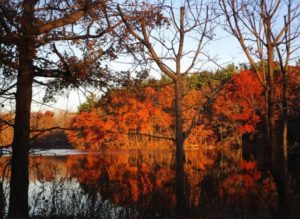 The foliage change of colors may be past its peak, but the colors continue to dazzle. Here, morning sunlight shines on a cove in a section of Farrington Lake on the East Brunswick-North Brunswick boundary in Middlesex County.
The foliage change of colors may be past its peak, but the colors continue to dazzle. Here, morning sunlight shines on a cove in a section of Farrington Lake on the East Brunswick-North Brunswick boundary in Middlesex County.
VOICES FROM AFIELD, DIANE LARSON, EAGLES: Diane Larson, who lives along Beaver Dam Creek in Brick, Ocean County, checked in: “Just wanted to share what happened (Sunday, November 26) morning. We noticed the seagulls abruptly flying, like they were spooked, then saw these two guys flying right above our house, and landed on the house across the lagoon from us!” Bald eagles, “Haliaeetus leucocephalus.” In New Jersey, the species is “endangered” as a breeder, or in immediate peril, and “threatened” otherwise, meaning if conditions continue, it could become “endangered.” “They flew in the area all morning, it was awesome to watch,” Diane said.
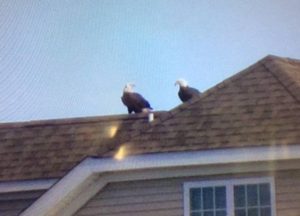
Two bald eagles in the Beaver Dam Creek area of Brick, Ocean County. (Photograph copyright 2017 by Diane Larson)
MORE EAGLES: Michael Franken has been reporting bald eagles from the boundary of Cranbury and Plainsboro in Middlesex County.
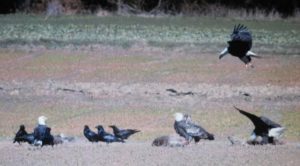
Bald eagles on a deer carcass along the Cranbury-Plainsboro boundary in Middlesex County. (Photo copyright 2017 by Michael Franken Photography)
VOICES FROM AFIELD, DIANE LARSON, NO. 2, JUNCOS: Diane Larson, who is the home horticulturist for the Monmouth County office of the Rutgers University Cooperative Extension, said, “I just went out to the back to check on the gardens behind our office. I heard unfamiliar bird sounds and followed them to see dozens of juncos (“Junco hyemalis,” or snowbird) on a tree back there. I then saw why they were there. They were all around the sweetgum tree (“Liquidambar styraciflua”) eating the seeds from the sweetgum balls.”
SNOWY OWLS: Reports are coming in of snowy owls, “Bubo scandiacus,” down from the Arctic. In recent years, I have heard two theories on the uptick of snowy owls in our area, both related to their food of choice, lemmings, “Dicrostonyx torquatus.” One is that there could be a shortage of lemmings, so the owls migrate farther than normal to find food. The other theory is there was an abundance of lemmings and because of this, owls prospered, having more offspring. A snowy owl story from nj.com: http://www.nj.com/ocean/index.ssf/2017/11/snowy_owl_explosion_expected_in_new_jersey_this_ye.html.
DRIVE-BY NATURALIST, STARLINGS: As I was walking through the Rutgers University campus in downtown New Brunswick, Middlesex County, I encountered a flock of starlings, flying and perching in trees. “For much of the year, they wheel through the sky and mob lawns in big, noisy flocks,” according to Cornell University’s All About Birds website. Starlings, “Sturnus vulgaris,” are non-native. “First brought to North America by (playwright William) Shakespeare enthusiasts in the 19th Century, European Starlings are now among the continent’s most numerous songbirds,” according to All About Birds.
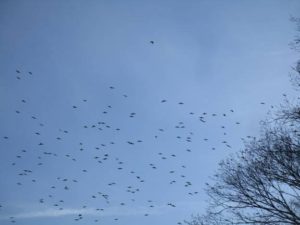
A flock of starlings at Rutgers University in New Brunswick, Middlesex County.
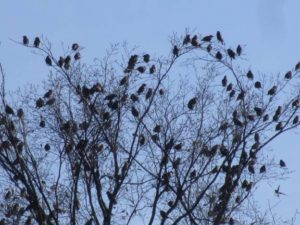
Perched starlings at Rutgers University in New Brunswick, Middlesex County.
DRIVE-BY NATURALIST, SUNSET: As I was headed to the Rocky Hill area of Somerset County, I came across a beautiful sunset on the Monroe-South Brunswick boundary in Middlesex County. It was a wonderful orange sky, with the farmland I was photographing across providing “big sky” views.

Sunset on the boundary of Monroe and South Brunswick, Middlesex County.
EARTHQUAKE: On Thursday, November 30, the rumble you may have felt was a 4.1 earthquake centered near Dover, Delaware. The Did-You-Feel-It response to the United States Geological Survey, https://earthquake.usgs.gov/earthquakes/eventpage/us1000bjkn#dyfi.
HURRICANE SEASON: The Atlantic Ocean hurricane season ended Thursday, November 30. During the season, which began June 1, there were 17 named storms of which 6 were major hurricanes, according to Channel 6 television in Philadelphia. “Three Category 4 hurricanes” – those with winds of 130 to 156 miles per hour — “made US landfall,” according to Channel 6. A primer on hurricanes from the National Hurricane Center, http://www.nhc.noaa.gov/aboutsshws.php.
‘LIVING SHORELINES’ PROPOSAL: Congressman Frank Pallone, who lives in Long Branch, is to introduce legislation creating the Living Shorelines Act, which would provide federal grant money for building up shorelines with plants and other natural materials. The idea is to prevent flooding and erosion, along with providing habitat, in a natural way. See Pallone’s op-ed in the Wednesday, November 29, Asbury Park Press, http://www.app.com/story/opinion/columnists/2017/11/29/living-shorelines-act-frank-pallone/108143866/.
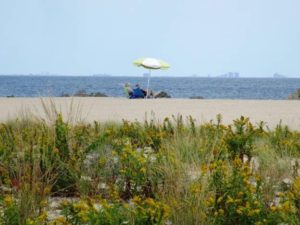
In this 2016 photograph, an Atlantic Ocean natural beach at Sandy Hook, Monmouth County, with the New York City area in the background.
CHRISTMAS TREES, SLIM PICKINGS AND HIGHER PRICES: We were just talking about how fewer trees were planted because of the Great Recession about 10 years ago. And, 10 years later, those trees are ready – in smaller numbers and, in turn, higher prices. Here is a New York Times story on the matter, https://www.nytimes.com/2017/11/30/business/christmas-tree-shortage-recession.html.
DEER RUT: A 63-year-old Franklin, Somerset County, died from injuries suffered in a motor-vehicle accident in his hometown that happened during the ongoing mating season, or rut, of deer, “Odocoileus virginianus.” Be careful while driving, especially during the rut, which will likely extend into about mid-December.
FULL MOON: The upcoming full moon — the Full Long Night Moon on the December 3-4, Sunday-Monday overnight — will be 2017’s only full “super moon,” that is, when the full moon comes close to the Earth, or 222,443 miles away. The closest will be at 4 a.m. Monday, December 4, when the moon will appear “about 7 percent larger and 16 percent brighter than usual,” according to the National Geographic.

The near-full moon around 4 a.m. from my backyard in Monroe, Middlesex County.
OCEAN TEMPERATURE: The Atlantic Ocean temperature at Sandy Hook was about 48 degrees over the Dec. 2-3 weekend.
SUNRISE/SUNSET: For Sunday, December 3, to Saturday, December 9, the sun will rise about 7:05 to 7:10 a.m. and set about 4:30 p.m. For Sunday, December 10, to Saturday, December 16, the sun will rise about 7:10 to 7:15 a.m. and set about 4:30 to 4:35 p.m.
WEATHER: The National Weather Service forecasting station for the area is at http://www.weather.gov/phi/.
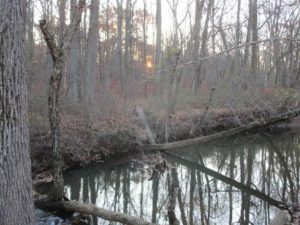
Sunrise at Manalapan Brook in Monroe, Middlesex County.
Joe Sapia, 61, is a lifelong resident of Monroe — in South Middlesex County, where his maternal family settled more than 100 years ago. He is a Pine Barrens naturalist and a gardener of organic vegetables and fruit, along with zinnias and roses. He draws inspiration on the Pine Barrens around Helmetta from his mother, Sophie Onda Sapia, who lived her whole life in these Pines, and his Polish-immigrant grandmother, Annie Poznanski Onda. He gardens the same backyard plot as did his Grandma Annie and Italian-American father, Joe Sr. Both are inspirations for his food gardening. Ma inspires his rose gardening. Joe is a semi-retired print journalist of almost 40 years. His work also is at @JosephSapia on Twitter.com, along with Facebook.com on the Jersey Midlands page.
Copyright 2017 by Joseph Sapia
Article and photos by Joe Sapia
Note: The yard references are to my house in the section of Monroe between Helmetta and Jamesburg in South Middlesex County. My yard is in a Pine Barrens outlier on the Inner Coastal Plain, the soil is loamy, and my neighborhood is on the boundary of Gardening Zones 6b (cooler) and 7a (warmer). Notes and photographs are for the period covered, unless otherwise noted.
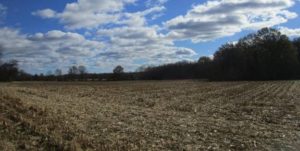
Farmers are harvesting field corn as fall turns into winter. Here, a cut-down cornfield in Monroe, Middlesex County. We have seen a wide fluctuation of temperatures this fall, from summer-like to winter-like, but look out for long days of cold, perhaps accompanied by snow.
FARMING: Look for the traditional farming season to wrap up. Farmers are continuing to harvest field corn, for example. Meanwhile, we are transitioning into the winter holidays season at Christmas tree farms.
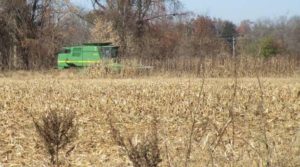
A farmer works a corn field outside Neshanic Station, Somerset County.
CHRISTMAS TREE FARMS: For those seeking trees from local farms, whether recent cuts or cut-your-own, here is the New Jersey Christmas Tree Growers Association website’s farm locater, https://njchristmastrees.net/find-a-farm/. Keep in mind, all Christmas tree farms may not be listed. (I heard an interesting radio news report regarding Christmas trees in America. The report said we are facing the effects of the recession 10 years ago – that is, with the recession, farmers planted less trees and with those trees now reaching cutting time, there are less trees. In turn, higher prices. The report said this will go on for years.)
DEER RUT: While I have not noticed any bucks roaming lately — because, I suspect, the mating season, or rut, of deer, “Odocoileus virginianus,” is peaking and bucks and receptive does are holed up in the seclusion of woods — I did come across a dead buck on farmland in Monroe, Middlesex County. It was a fresh kill and near a busy road, so he probably was a victim of a motor vehicle accident. Additionally, he was probably sex-crazed and less wary, crossed the road, and got hit. I noticed the dead buck because nature was taking its course and vultures were feasting upon him. Definitely turkey vulture, “Cathartes aura”; Maybe black vulture, “Coragyps atratus,” too.
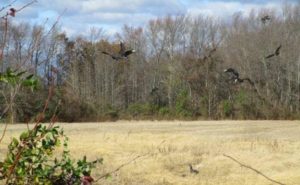
I spooked these vultures when I stopped to photograph them on a deer carcass in Monroe, Middlesex County. Notice the dead buck on the middle-to-right bottom of the photograph.
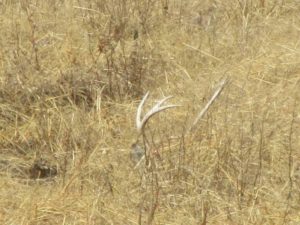
The dead buck appeared to be a pretty good size.
DEER HUNTING: Various deer-hunting seasons have been underway and will continue into 2018, with “Deer Week,” or the Six-Day Shotgun Season, being Monday, December 4, to Saturday, December 9. (If you are traveling through the Pine Barrens, take note of those primitive buildings that are quiet for 51 weeks of the year. During Deer Week, they will be hopping.) Anyway, be careful if heading into the woods during deer seasons. One, it might be advisable to stay out of the woods. Two, if you are in the woods, at least wear blaze orange. Three, during Deer Week, just stay out of the woods unless you are hunting. A year or so ago, I walked underneath a bowhunter in a deer-stand, never seeing him until he spoke to me from above. Fortunately, I wore blaze orange and was obvious to him. This rattled me into thinking I am not as aware of my woods surroundings as I should be.
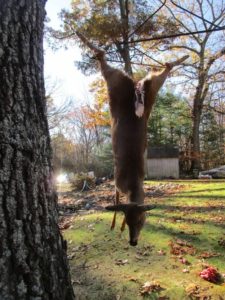
This doe was killed in the Route 33 area of Manalapan, Monmouth County.
FALL FOLIAGE: The Jersey Midlands are past the peak of the changing colors of fall, but there were some beautiful brown/Earth-tone views.

Fall foliage and a cloudy sky at Westminster Cemetery in Cranbury, Middlesex County.

A sunny day upon the fall foliage along Manalapan Brook in Monroe, Middlesex County.
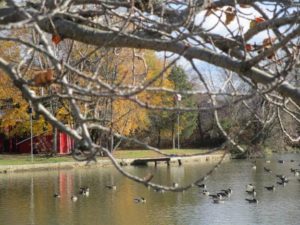
“Englishtown Lake” (properly Lake Weamaconk) in Monmouth County. The lake is formed by the damming of Weamaconk Creek, part of the Raritan River-Bay watershed.
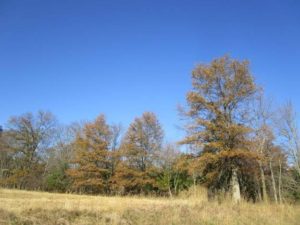
Farmland below Sourland Mountain in Montgomery, Somerset County.
SOURLAND MOUNTAIN: This week, I had to go to Hillsborough, Somerset County, to attend a funeral service. Because I was nearby, I took a ride to Sourland Mountain on the boundary of Somerset, Hunterdon, and Mercer counties. Sourland Mountain, also known as Neshanic Mountain and Zion Mountain, sits on the Piedmont geological area. It runs about 10.5 miles by 4.5 miles and rises about 570 feet above sea level, with its surrounding lowlands as low as about 90 feet above sea level.

Looking across farmland at Sourland Mountain at Montgomery, Somerset County.

Fencing to hold back snow drifting on roads at Montgomery, Somerset County.
RARITAN RIVER SOUTH BRANCH: The South Branch of the Raritan River is 51 miles long, draining 276 square miles in Somerset, Hunterdon, and Morris counties. It meets the North Branch north of Neshanic Station, forming the main stem of the Raritan River.
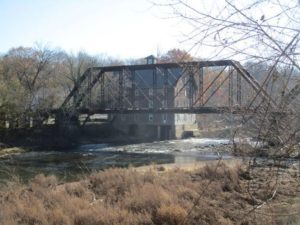
An old railroad bridge and mill on the South Branch of the Raritan River at Neshanic Station.
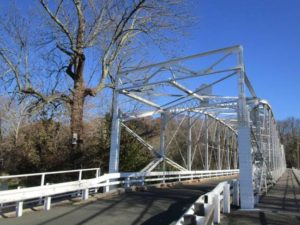
The one-lane, 1896 iron bridge over the South Branch of the Raritan River, connecting Branchburg and Hillsborough at Neshanic Station, Somerset County.
VOICES FROM AFIELD, EAGLES: Michael Franken checked in regarding bald eagles, “Haliaeetus leucocephalus.” He reported seeing them on the boundary of Cranbury and Plainsboro, Middlesex County, Thanksgiving Day and Black Friday. In New Jersey, the bald eagle is “endangered,” or in immediate peril, as a breeder and “threatened,” or if conditions continue or begin to deteriorate, they will advance to endangered, in general. The state Division of Fish and Wildlife bald eagle page is http://www.state.nj.us/dep/fgw/ensp/pdf/end-thrtened/baldeagle.pdf.
DRIVE-BY NATURALIST, BIRD OF PREY: I was driving through a farming area of South Brunswick, Middlesex County, and came across a bird of prey perched in a tree. I could not get a good look or a good photograph of the bird. Later, in looking at the photo on my computer, the bird’s head appeared to be somewhat, perhaps not that blatantly, lighter than the body. A bald eagle, “Haliaeetus leucocephalus,” transitioning from juvenile to adult?
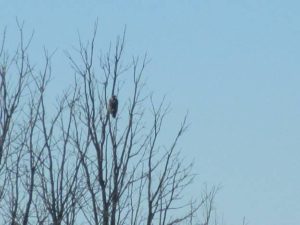
A bald eagle, “Haliaeetus leucocephalus,” transitioning from juvenile to adult?
FULL MOON: The upcoming full moon — the Full Long Night Moon on the December 3-4, Sunday-Monday overnight — will be 2017’s only full “super moon,” that is, when the full moon comes close to the Earth, or 222,443 miles away. The closest will be at 4 a.m. Monday, December 4, when the moon will appear “about 7 percent larger and 16 percent brighter than usual,” according to the National Geographic.

Around 5 p.m. November 20, Monday, or a short time after sunset, there was a beautiful rainbow-shaped and -colored cloud in the western sky. The color was caused by the reddish sunlight from under the horizon hitting the cloud. And more toward the southwest was the crescent moon. What a view! (The photos, all shot from my yard, from where I have watched the night sky since the American-Soviet “Space Race”: the moon, stars, planets, meteorites, and the International Space Station.)
DARK SKIES: As you probably can tell, I am a big fan of a dark sky, to be able to see the stars, planets, satellites clearly. When I remodeled my house over the summer, I insisted on shielded outside lighting, which directs my three outside lights downward, not horizontally or upward. (At night, a shielded light will emit a cone of light, while an unshielded light emits a blinding burst of light. Also, red and green lights protect night vision.) On Saturday, November 25, I heard this story on NPR, about a proposal for part of Idaho to get recognized by the International Dark-Sky Association as a “dark sky reserve,” https://www.npr.org/2017/11/25/566074921/idaho-dims-the-lights-for-one-of-the-best-night-skies-anywhere. Go, Idaho! (I plan to be in Idaho for a wedding in August and hope to see that Idaho dark sky. Give people a wonderful view – turn off lights that project into the sky!)
AROUND PEDDIE LAKE: There were some nice views at Peddie Lake at Hightstown, Mercer County. The lake is about 15 acres, created by the damming of Rocky Brook, part of the Raritan River-Bay watershed. The Peddie School, a preparatory school, sits along the lake.

A fisherman on Peddie Lake under a partly cloudy sky.
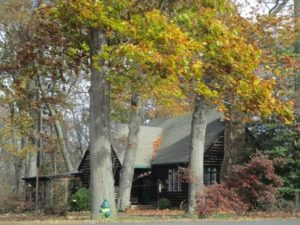
The Peddie Lake cabin.
PROTECTING THE JERSEY MIDLANDS: The Jersey Midlands are an incredible environmental resource: the Atlantic Ocean and other coastal waters, the Outer and Inner Coastal Plains, the Piedmont, the Pine Barrens, the Delaware River, valuable farmland. This alone is evidence of why we should protect the Midlands environment. But, more so, the area is under intense development pressure and stress because of its location at the New York City and Philadelphia metropolitan areas.
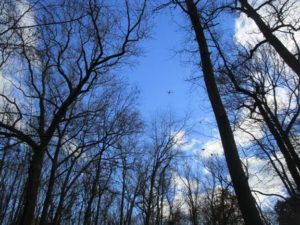
Despite the beauty here of the blue sky above the Manalapan Brook floodplain in Monroe, Middlesex County, notice the commercial jet in the sky, probably headed for Newark Airport. The Midlands are under intense stress because of they are part of both the New York City and Philadelphia metropolitan areas.
OCEAN TEMPERATURE: The Atlantic Ocean temperature at Sandy Hook was about 47 degrees over the November 25-26, Saturday-Sunday, weekend.
SUNRISE/SUNSET: For November 26, Sunday, to December 2, Saturday, the sun will rise about 6:55 to 7:05 a.m. and set about 4:30 to 4:35 p.m. For Sunday, December 3, to Saturday, December 9, the sun will rise about 7:05 to 7:10 a.m. and set about 4:30 p.m.WEATHER: The National Weather Service forecasting station for the area is at http://www.weather.gov/phi/.
CLOUDS: This week’s cloud photographs were captured at Monroe and Jamesburg, Middlesex County.

“Jamesburg Lake” (properly Lake Manalapan), looking from Monroe toward Jamesburg, Middlesex County.
IN THE GARDEN AND YARD: I try to get the yardwork done by Thanksgiving weekend. So far, the lawn has been cut for the last time, shrubs have been spruced up in the front yard, the gutters and drainpipes have been cleaned in the front of the house, the crawlspace where a two-room addition was put on the house circa 1967 has been secured, and the garage door and front cellar window well has been cleaned. Still to go, sprucing the backyard shrubs, cleaning the rear gutters and drainpipes, raking leaves into the garden, and, perhaps, roto-tilling the garden. I will not get the outside painting I had planned done. As the outside work ends, I have a ton of stuff to do inside over the winter.

The garden in my backyard in August.
 This week in the garden.
This week in the garden.
UNEXPECTED WILDLIFE REFUGE: A little south of the Jersey Midlands, in Atlantic County, are our friends at the Unexpected Wildlife Refuge. Veronica Van Hof, the director, is seeking help in meeting a challenge. “As another way of supporting the Refuge, we have been accepted to be part of the Newman’s Own Foundation $500,000 Holiday Challenge, administered through CrowdRise,” Veronica said. “Every donation (‘voting’) through our page at CrowdRise increases the chance of our receiving additional funding through one of the Challenge prizes which range from $2,500 for 10th place up to $150,000 for first place.” The challenge runs to January 3. The challenge is at https://www.crowdrise.com/o/en/campaign/unexpected-wildlife-refuge-inc/unexpected-wildlife-refuge. More about Unexpected is at http://www.unexpectedwildliferefuge.org.
UPCOMING:
December 3, Sunday, 10 a.m. to 1 p.m. – Green Brook Cleanup at the Green Brook Regional Center, 275 Greenbrook Road, Green Brook, Somerset County, with the Lower Raritan Watershed Partnership and the Central Jersey Stream Team. More information at hfenyk@lowerraritanwatershed.org.
December 8, Friday, 2 p.m. to 3:30 p.m., Middletown, Monmouth County – “Forest Therapy” Walk, hosted by the Monmouth Conservation Foundation. “It is not intended to be a strenuous hike, but a time for mindful awareness in nature,” according to the foundation. More information, abrockwell@monmouthconservation.org.

This turkey survived Thanksgiving. (Compliments of the eclectic Joey Archives: A plastic turkey from my 1960s youth, pictured in the faux cabin section of my basement.)
Joe Sapia, 60, is a lifelong resident of Monroe — in South Middlesex County, where his maternal family settled more than 100 years ago. He is a Pine Barrens naturalist and a gardener of organic vegetables and fruit, along with zinnias and roses. He draws inspiration on the Pine Barrens around Helmetta from his mother, Sophie Onda Sapia, who lived her whole life in these Pines, and his Polish-immigrant grandmother, Annie Poznanski Onda. He gardens the same backyard plot as did his Grandma Annie and Italian-American father, Joe Sr. Both are inspirations for his food gardening. Ma inspires his rose gardening. Joe is a semi-retired print journalist of almost 40 years. His work also is at @JosephSapia on Twitter.com, along with Facebook.com on the Jersey Midlands page.

























































































































































































